1lumen selects and reviews products personally. We may earn affiliate commissions through our links, which help support our testing.
Powertac Dreadnought review
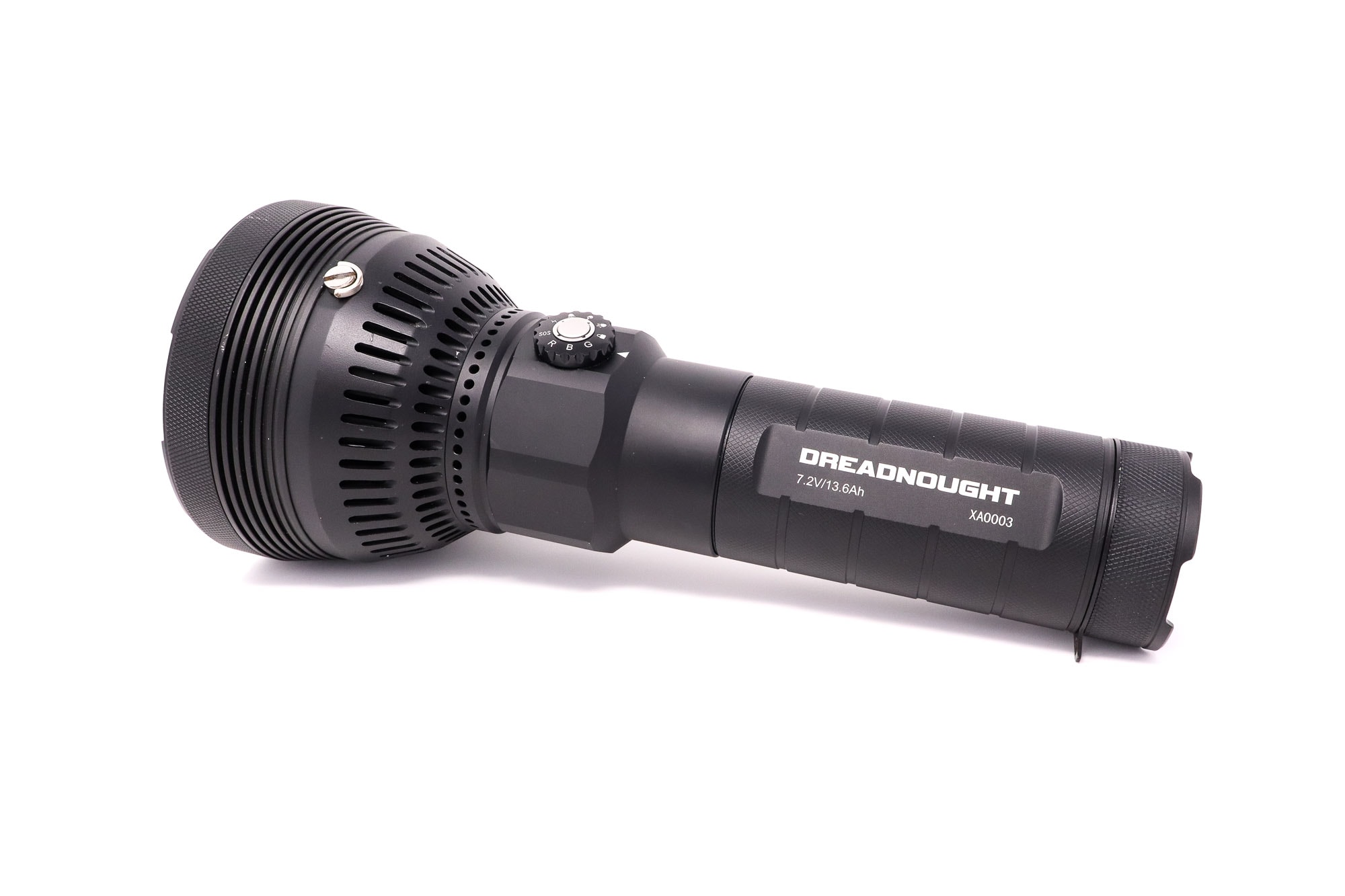
Powertac Dreadnought specifications
| Brand & Model | Powertac Dreadnought |
|---|---|
| Flashlight category | Lumen monster / long-range / searchlight |
| LED | 28x Cree XHP70.2 (?) + LEP + XML Color (?) |
| Max. output | 120,000 lumens |
| Max. beam distance | 2,800 meters |
| Max. beam intensity | 1,960,000 cd |
| Battery config. | Built-in |
| Onboard charging | Yes |
| Main modes | 14 |
| Blinkies | Strobe, SOS, color Strobe |
| Waterproof | IPX6 |
| Review publication date | March 2024 |
Review intro:
It’s been a few years since I’ve had the pleasure of reviewing a Powertac flashlight. Part of that could be that they don’t necessarily focus on the enthusiast crowd. Powertac definitely seems to cater to more of a duty / police / first responder kind of market. And that’s just fine! Realistically, those people need a flashlight that can perform, not just have a bunch of flash features or outrageous claims.
So, I’ll be honest in saying that I’m a bit surprised to have been offered another Powertac flashlight for review. But this isn’t any ordinary flashlight. The Powertac Dreadnought is an absolute beast of a light, combining a monster flood light with an LEP and an RGB light. Intrigued? I sure am! Let’s check it out, shall we?
What’s in the package
The Powertac Dreadnought didn’t arrive in any sort of fancy packaging. It came in a huge, plain cardboard box with loads of air pillows and bubble wrap. But if you’re the kind of person that ends up ordering one of these bad boys, don’t worry – the Dreadnought arrived this way because it is currently a pre-release flashlight. I’m sure you’ll get a highly polished box and goodies to go with it. This one, though, arrived in barebones fashion – just the necessities carefully packaged into a box. The box contained:
- Powertac Dreadnought
- Shoulder strap
- Charging cable
- International power adapter to accommodate the Euro plugs on the charging cable
While I can understand that not everything has been finalized yet, one unfortunate item that is missing is the user manual. I’m guessing that’s still being worked on. But in the meantime, that means I need to just use my best guess on a few things like construction, UI, etc.
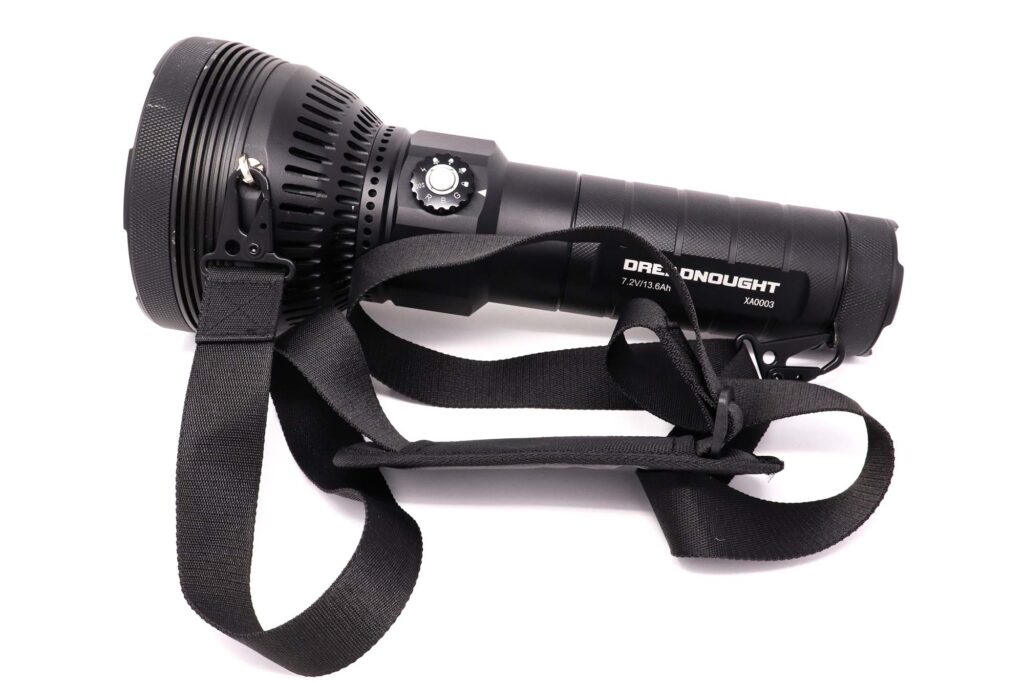
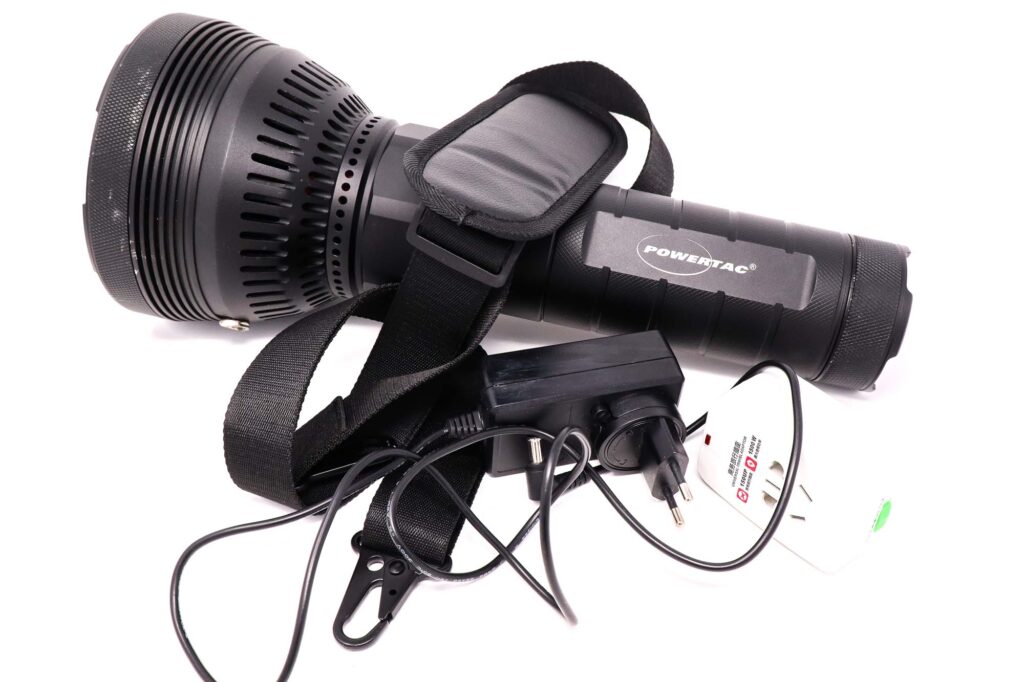
Flashlight in use, Build Quality, and Warranty
Let’s cut to the chase – the Powertac Dreadnought is huge. It’s big enough that I audibly laughed when I picked it up for the first time. For those of you that were around BudgetLightForum around 7 years ago, that might ring a bell – that’s when “Giggles” was developed (also known as the BLF GT), aptly named because you couldn’t help but giggle when holding one. The Dreadnought is even bigger than the BLF GT.
With as big and heavy as it is, it’s a good thing that the Dreadnought comes with a high-quality shoulder strap. That way, if you’re trudging through the countryside with this massive light, it won’t wear out your hands (but your shoulder may be another thing!). The base of the head also features a threaded hole for mounting on a tripod. That could be pretty handy if you need to light up a whole hockey rink for a nighttime match; just make sure that your tripod is up to the task.
The Powertac Dreadnought looks like a “normal” flashlight that has been stretched out to ridiculous proportions. There’s a switch arrangement at the base of the head of the flashlight. The switch consists of a magnetic (?) ring with an e-switch in the center. The ring is used for output selection (flood, LEP, RGB, etc) and the e-switch is for on/off/modes.
While it may not be readily apparent, the base of the head hides an internal cooling fan. That’s an almost mandatory feature for a flashlight that boasts this many lumens and wants to run for more than a minute or two. The fan does an excellent job of keeping the Dreadnought at comfortable working temperatures (topping out around 51°C), though it is very loud. When testing the Dreadnought indoors, you can hear the fan throughout much of the house. That’s not amazing, but it’s a trade-off that I’m willing to accept for extended runtimes at crazy high output.
Again, I don’t have specs on the construction of the Dreadnought (material, anodizing, etc). But I will say that it appears to be solidly built – this thing is a tank. The anodizing is good, but you will notice some imperfections in the appearance in some pictures. That’s because this is a prototype unit and had some handling before it arrived at my doorstep. Powertac knows how to build flashlights, and I’m sure retail units will be in fine shape.
With Powertac focusing pretty heavily on the law enforcement / first responder segment, it’s not too difficult to imagine the Dreadnought being used for search & rescue operations. Need a long-distance searchlight? The LEP module has you covered. Need an absolute wall of light that stays strong? No problem! Need red, green, or blue lighting for some strange reason? Yeah, the Dreadnought does that.
Warranty:
- In short, Powertac products are covered by a lifetime warranty. But in their words…
- “Powertac warranties our illumination tools to be free from defects in workmanship and materials, including any leds housed within, for life. If it is determined by us to be defective, we will repair or replace your original purchase of these products, at our discretion.”
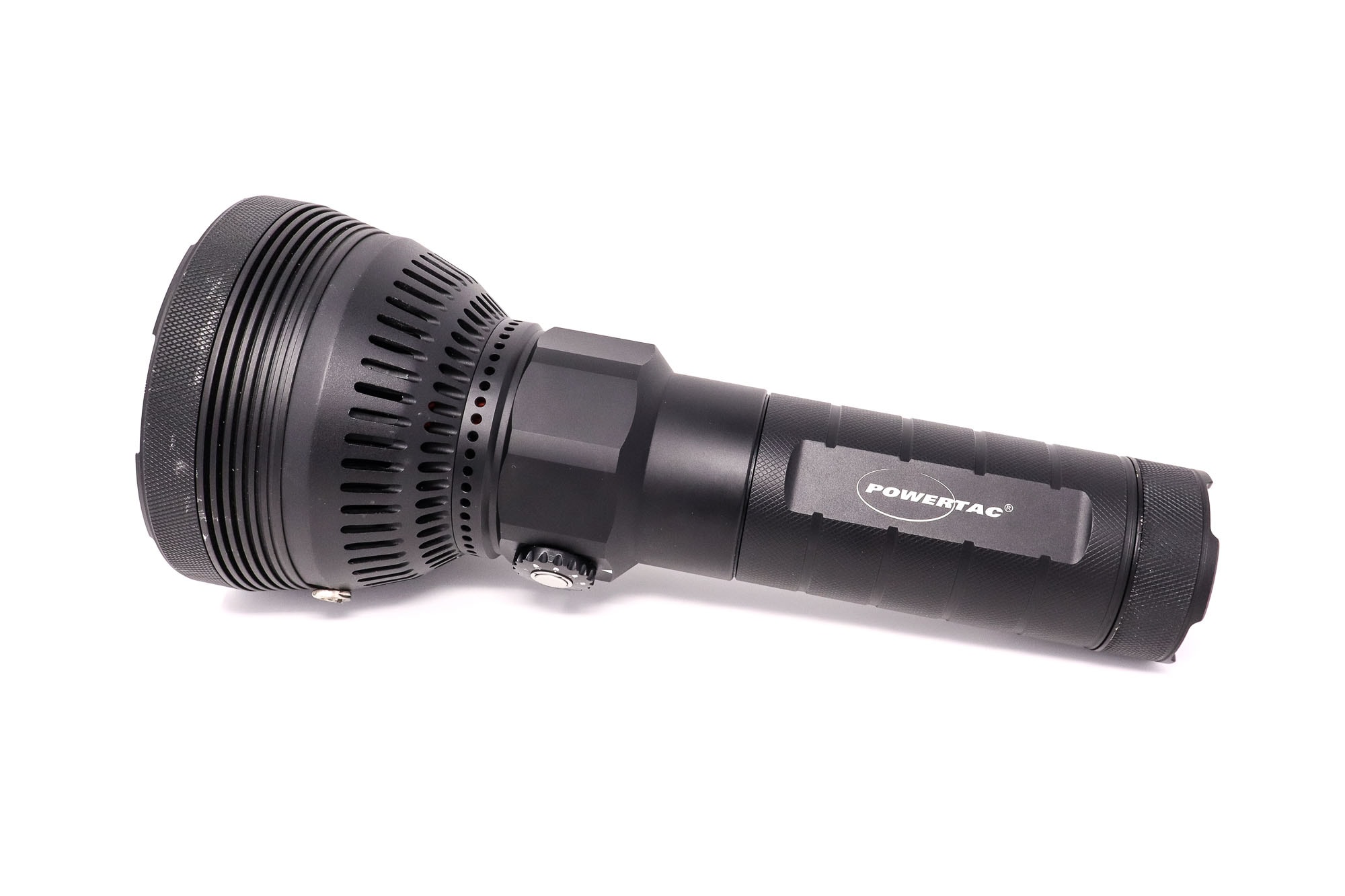
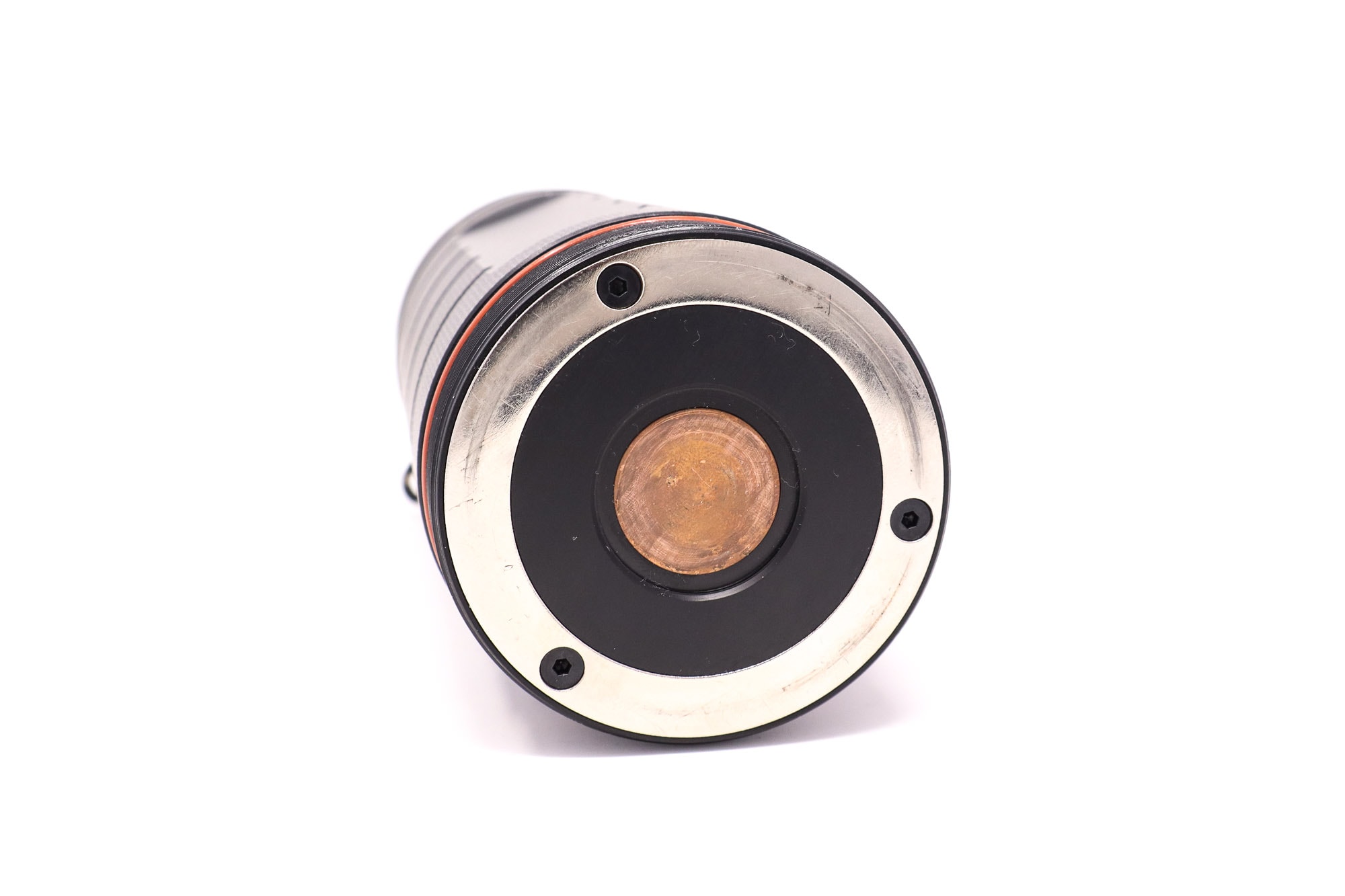
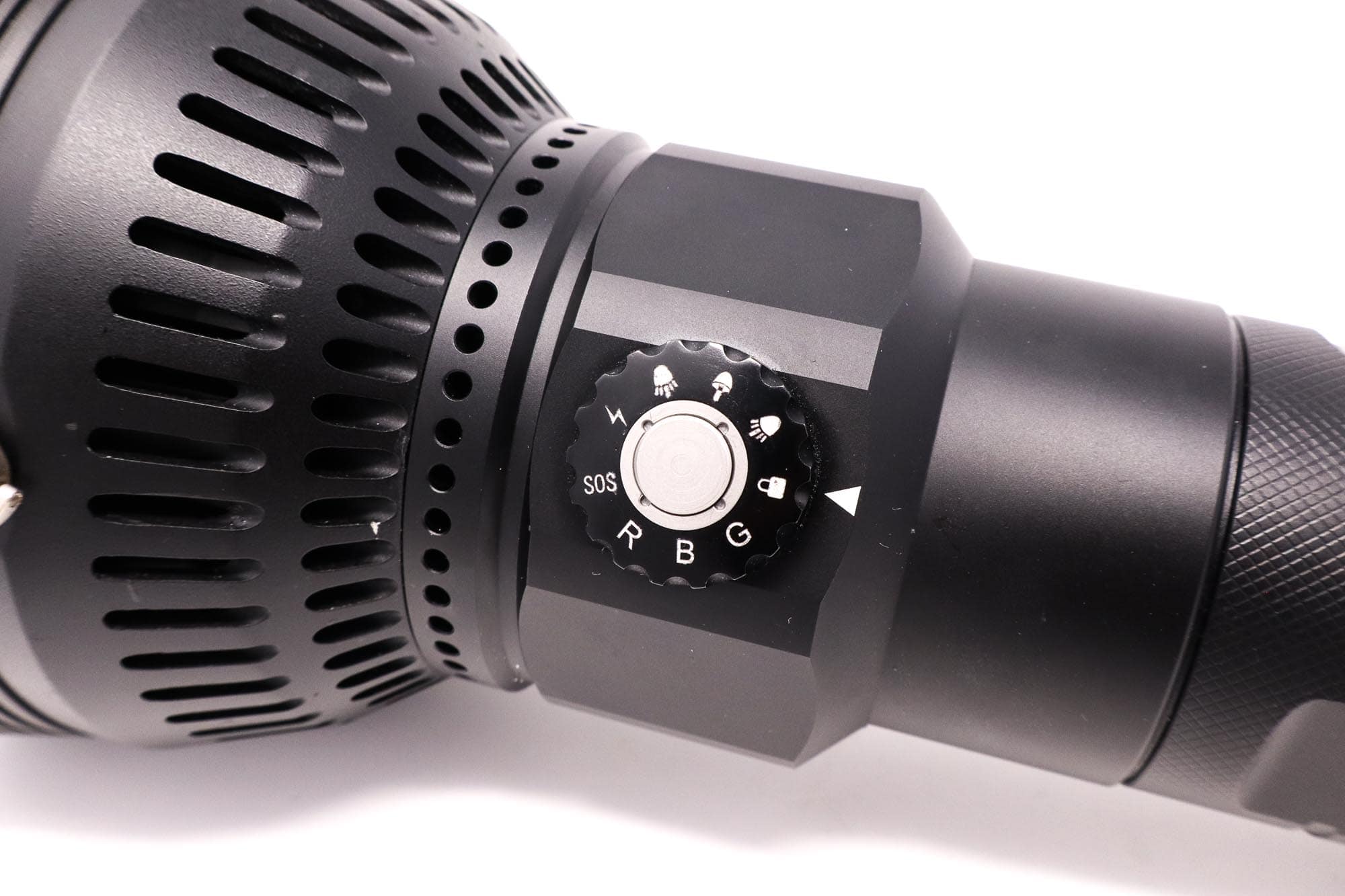
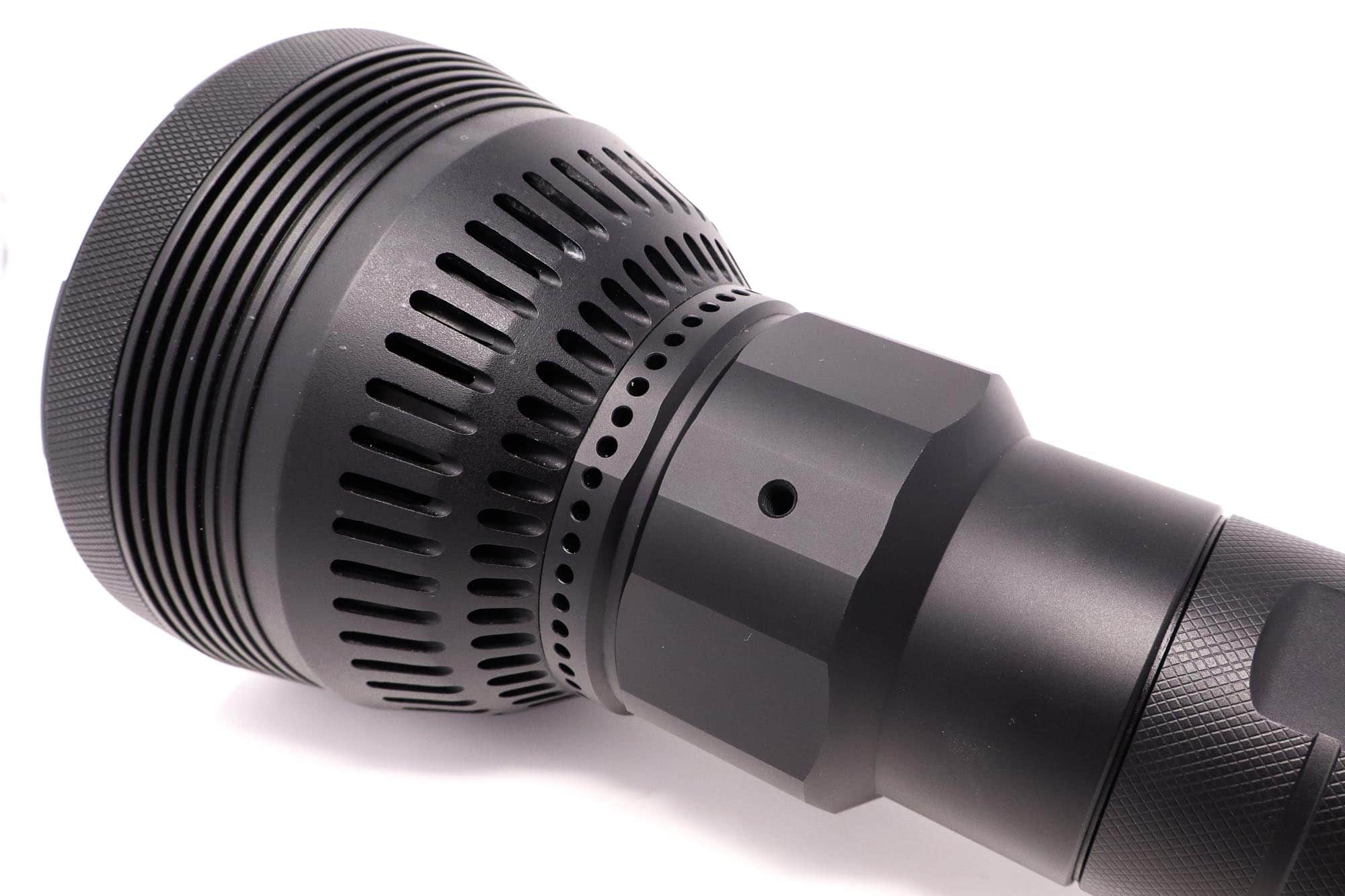
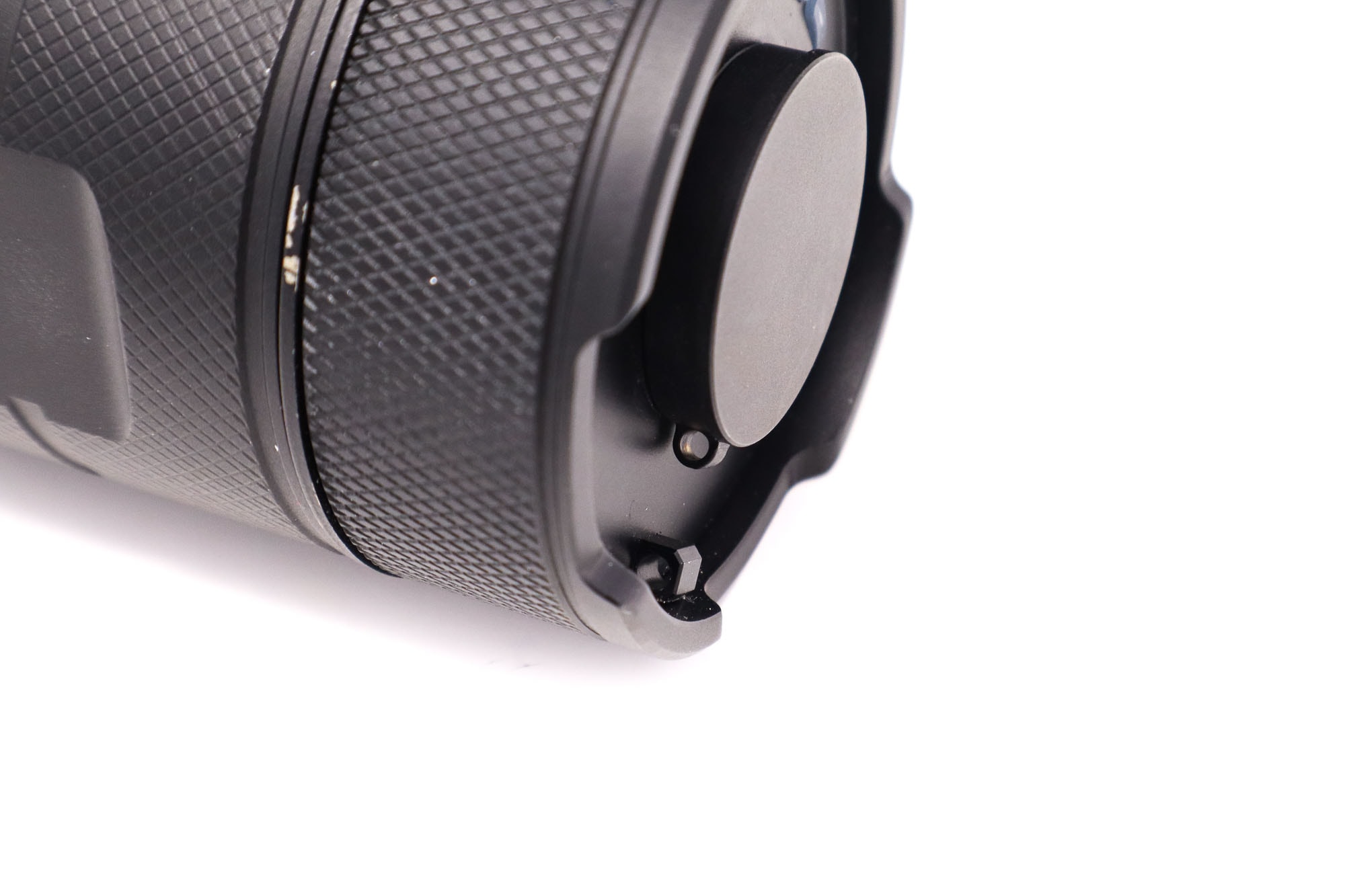
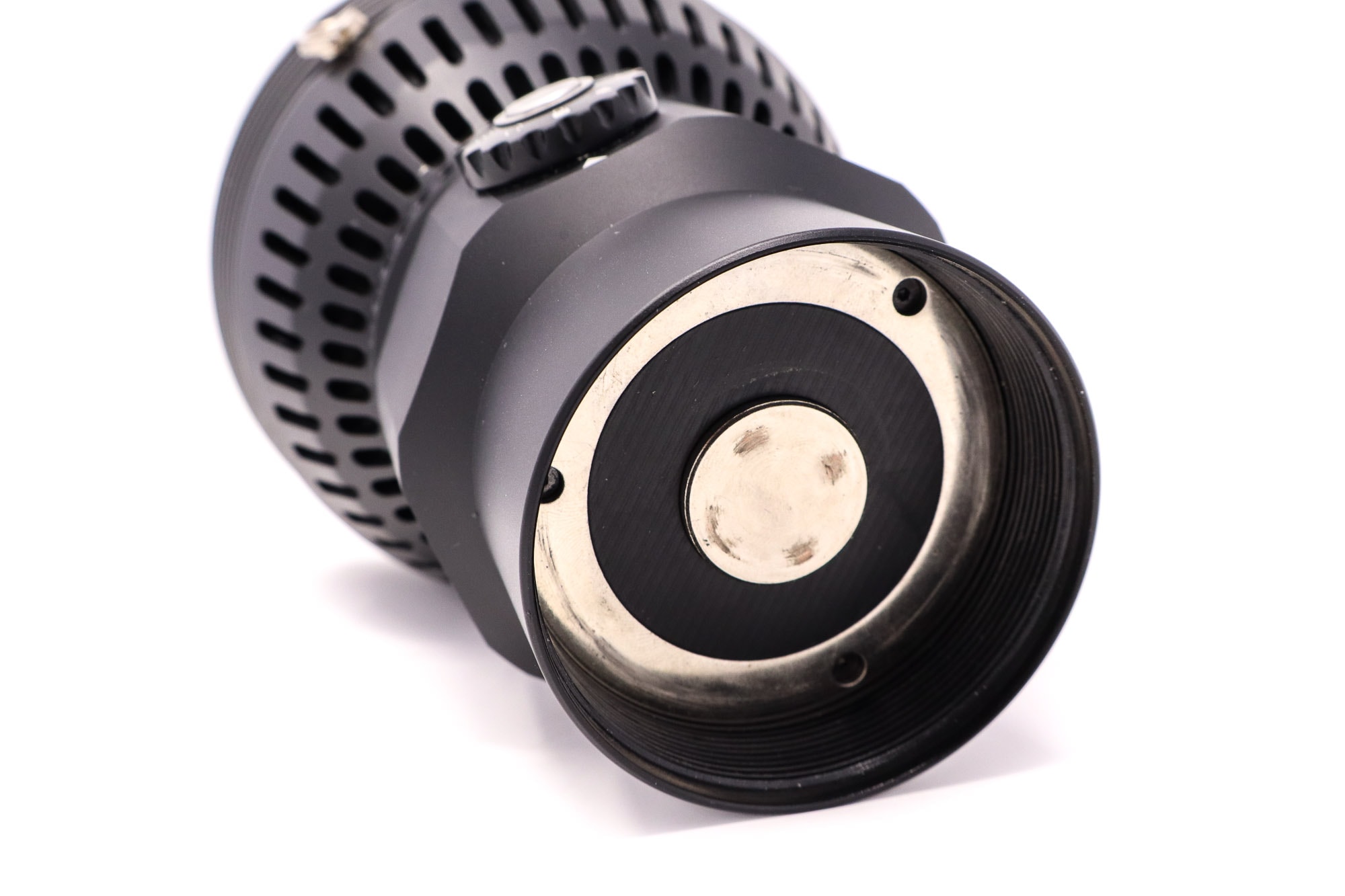
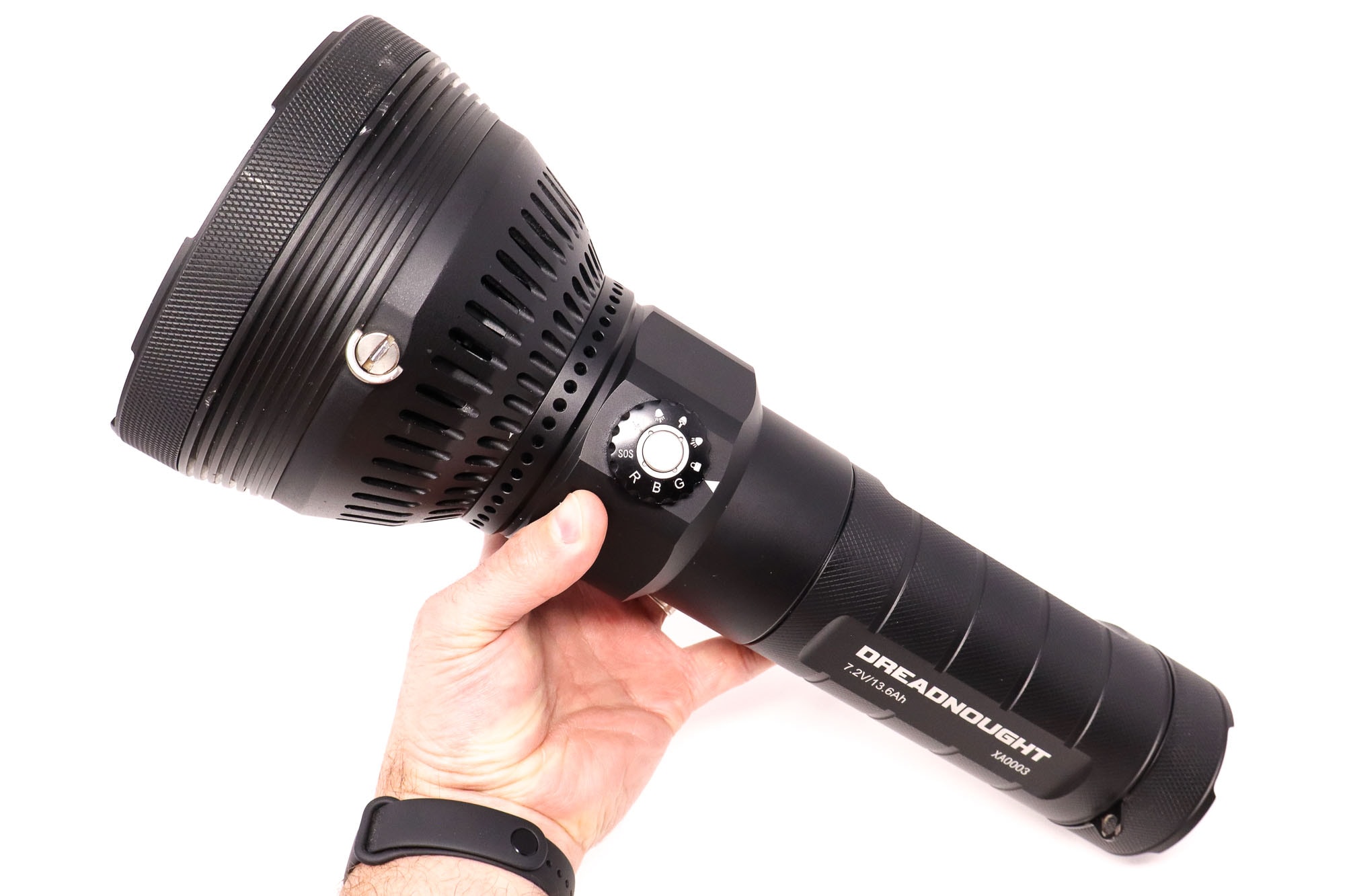
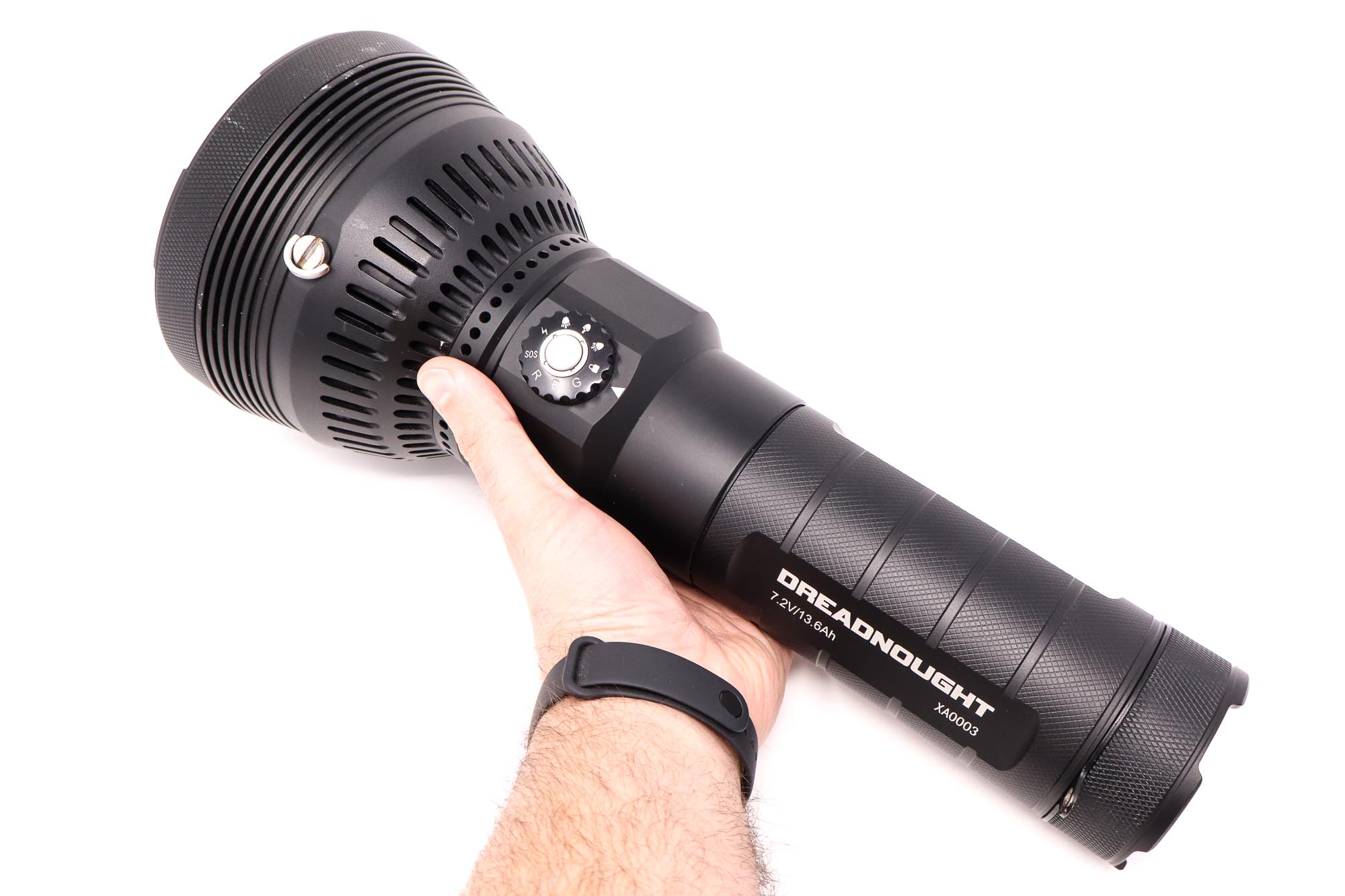
LED, Lens, Bezel, Beam, and Reflector
As I mentioned earlier, there isn’t a manual that I can reference, nor have I seen much as far as marketing/literature goes. So I’ll lay out my observations. The business-end of the Powertac Dreadnought has a lot going on. The first thing you’ll notice is a whole lot of big (7070) LEDs around the perimeter of the head. I count 28 of them, and they appear to be Cree XHP70.2 LEDs. Those LEDs are situated in smallish orange-peel reflectors. One stands out – the 29th reflector has a fairly unusual LED in it. That LED appears to be a Cree XM-L Color (RGBW) LED. I don’t know exactly why you’d need relatively low output red / green / blue channels in such a massive flashlight, but I guess it doesn’t hurt to have them available.
Centered right in the middle of everything is an unmistakable light source – an LEP. While those 28 big LEDs can produce a wall of light, the LEP in the middle brings an unprecedented amount of throw, more than what you’d find with any ordinary LED. While the LEP (laser-excited phosphor, essentially a white laser) doesn’t produce a lot of lumens, it does generate a very intense beam that throws for a very long way.
Spectral measurements:
I used the Opple Light Master to measure the flashlight at 10 meters distance.
| Mode: | CCT: | CRI Ra: | duv |
|---|---|---|---|
| Combo | 6124 K | 63.4 | +0.0151 |
| Floodlight | 5965 K | 69.8 | +0.0021 |
| LEP | 6195 K | 57.7 | +0.0130 |
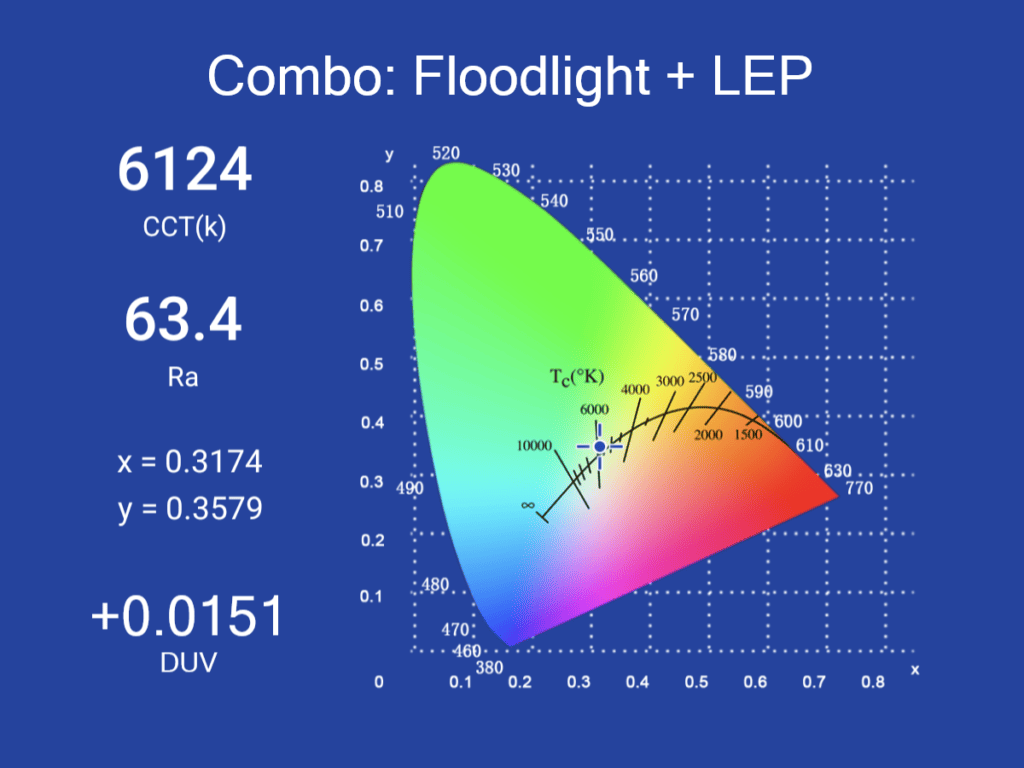
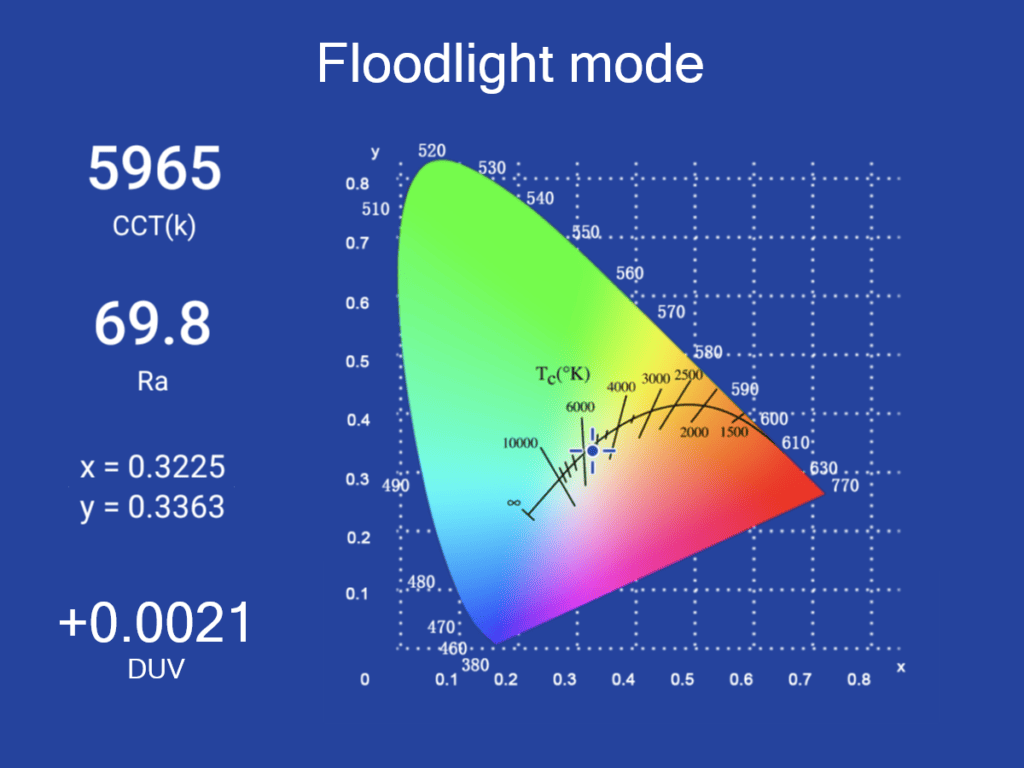
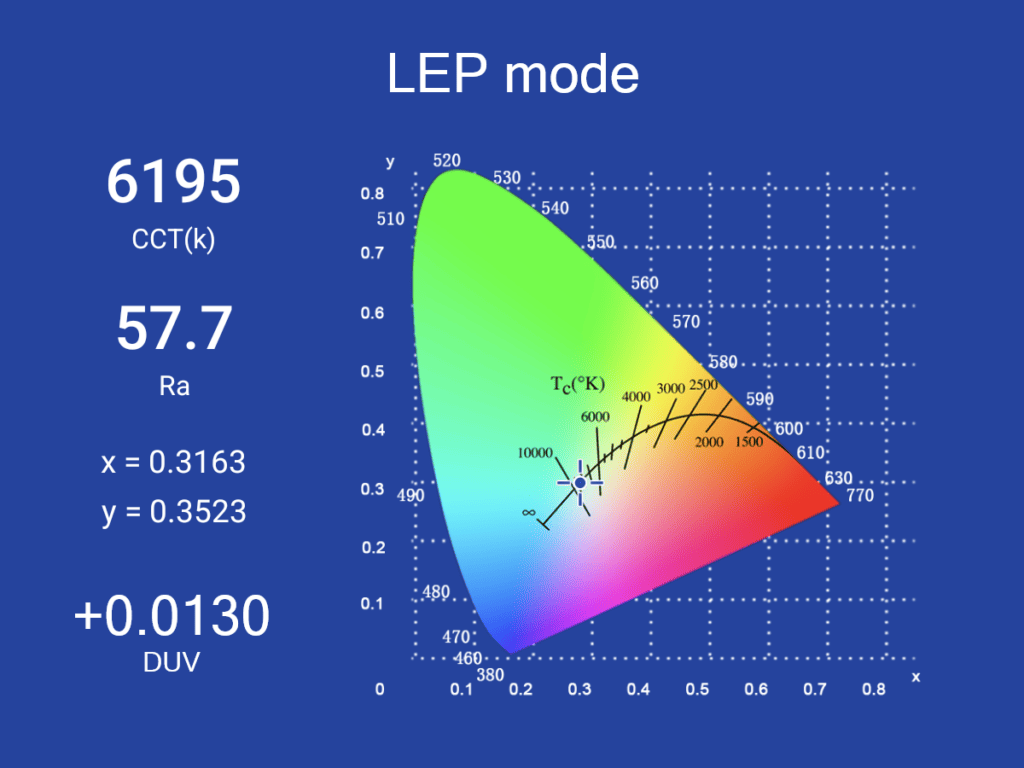
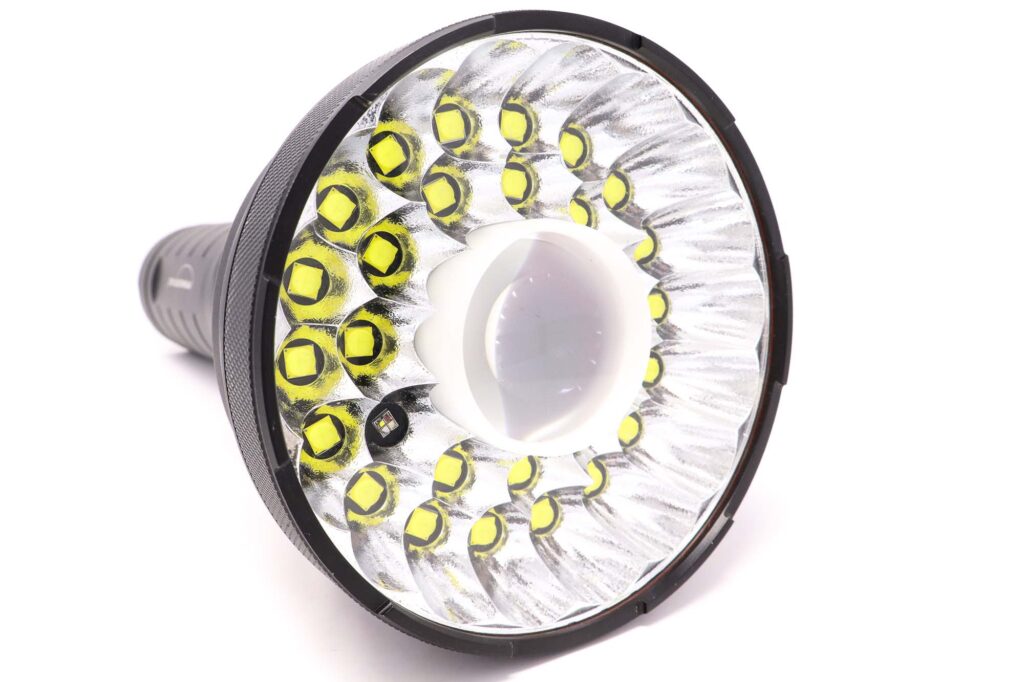
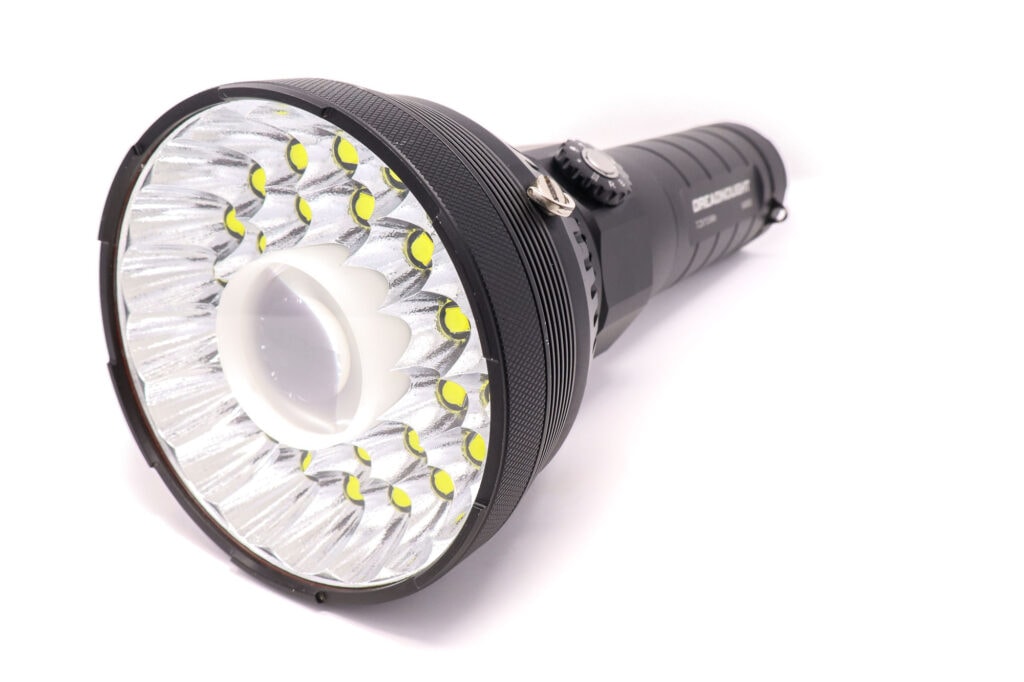
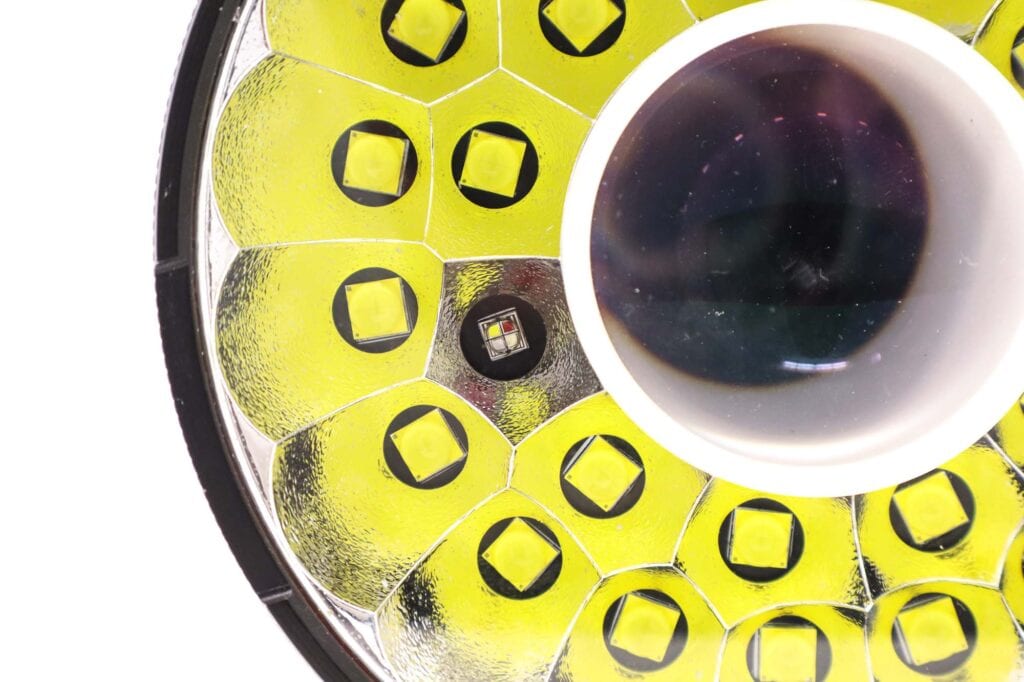
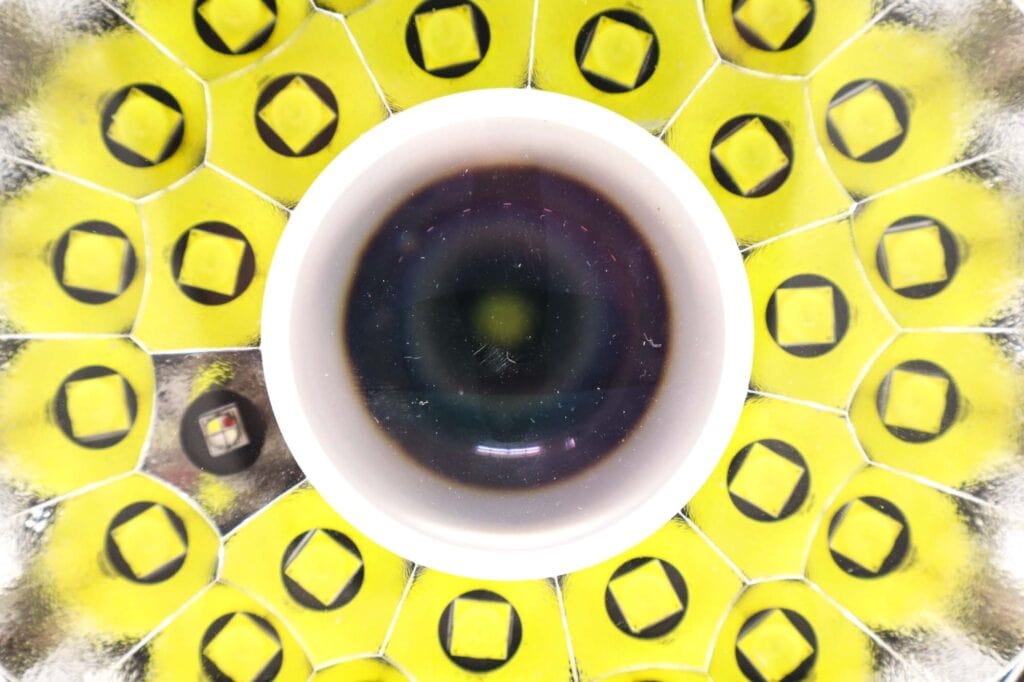
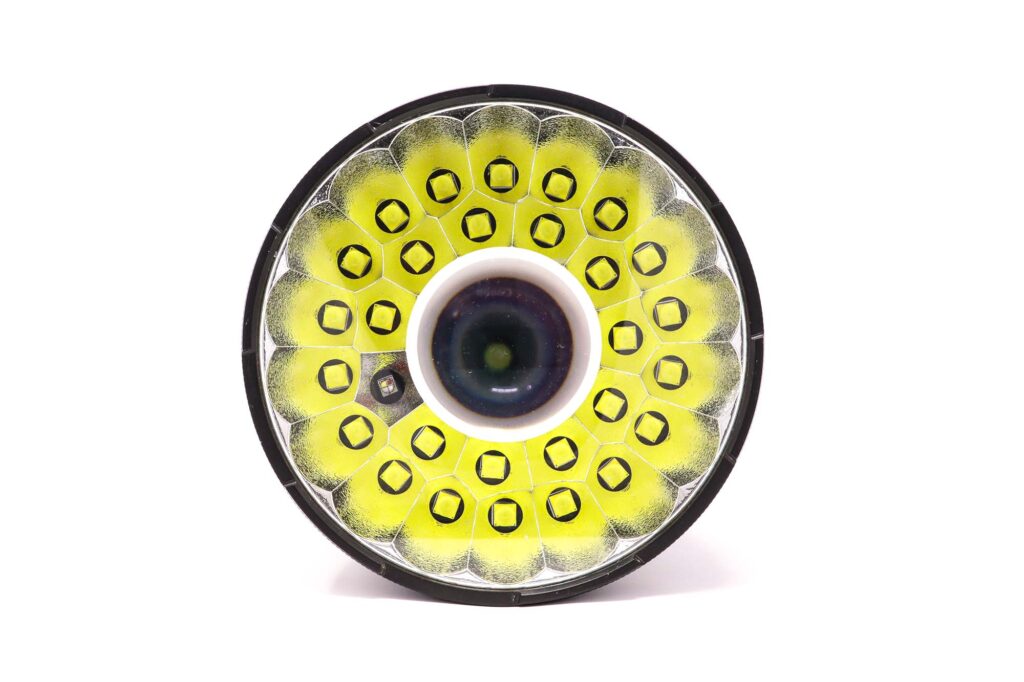
Dimensions and its competition
Dimensions:
| Powertac Dreadnought | Millimeters | Inches |
|---|---|---|
| Length | 368 mm | 14.5 in |
| Head diameter | 150 mm | 5.9 in |
| Body diameter | 71 mm | 2.8 in |
Dimensions are rounded to the nearest millimeter and the nearest tenth of an Inch.
Weight:
| Powertac Dreadnought | Weight in grams | Weight in oz |
|---|---|---|
| With battery | 3,691 g | 130.2 oz (8 lbs 2.2 oz) |
Weight is rounded to the nearest gram and tenth of an Oz.
Flashlight size comparison with its competition:
Group 1: Powertac Warrior LT G5, Powertac Dreadnought
Group 2: Olight Baton 3 Pro Max, Acebeam E75, Powertac Dreadnought, Nitecore P20iX, Nitecore EDC33
Group 3: Lumintop DF11, Powertac Dreadnought, Astrolux EC01X
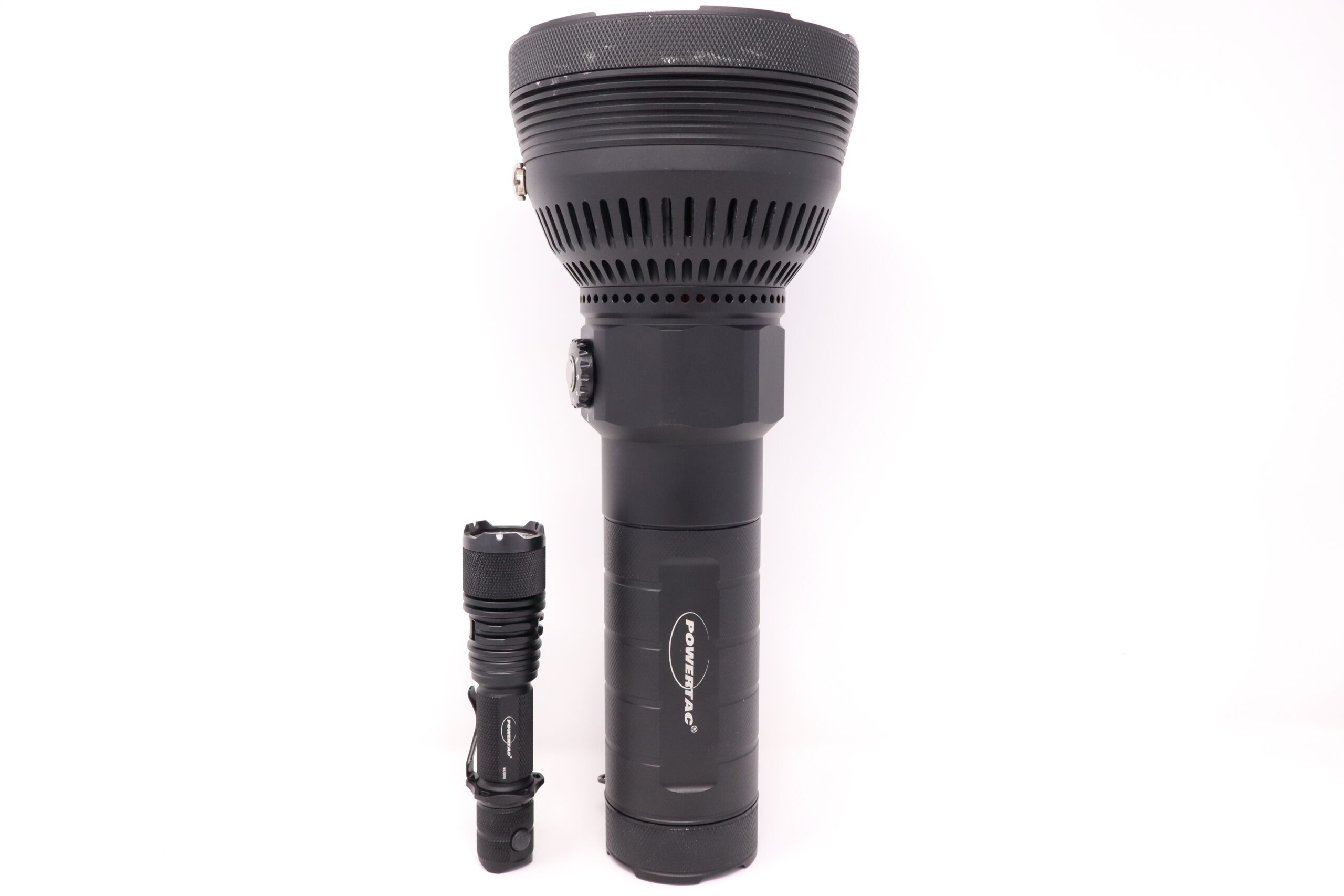
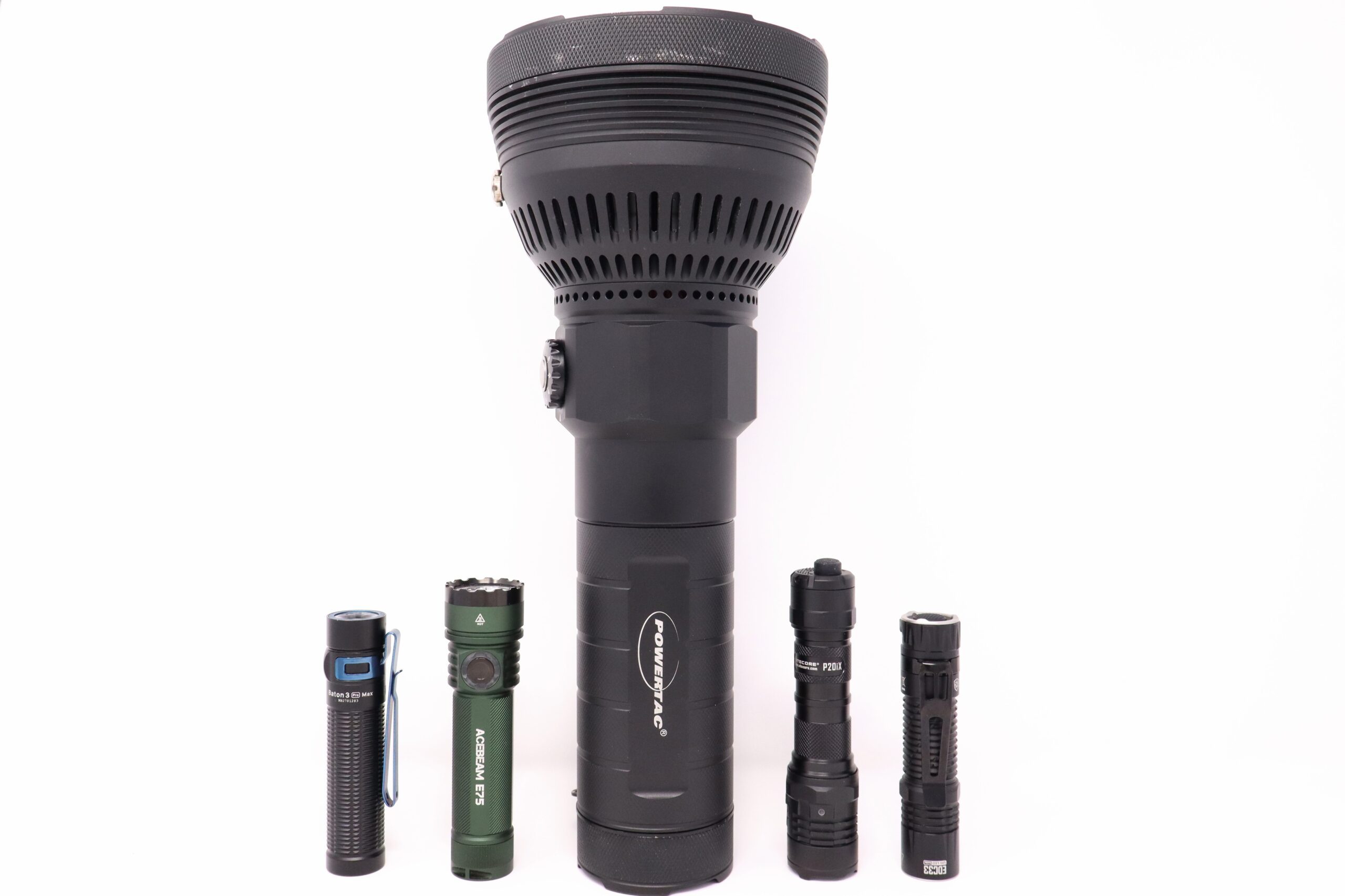
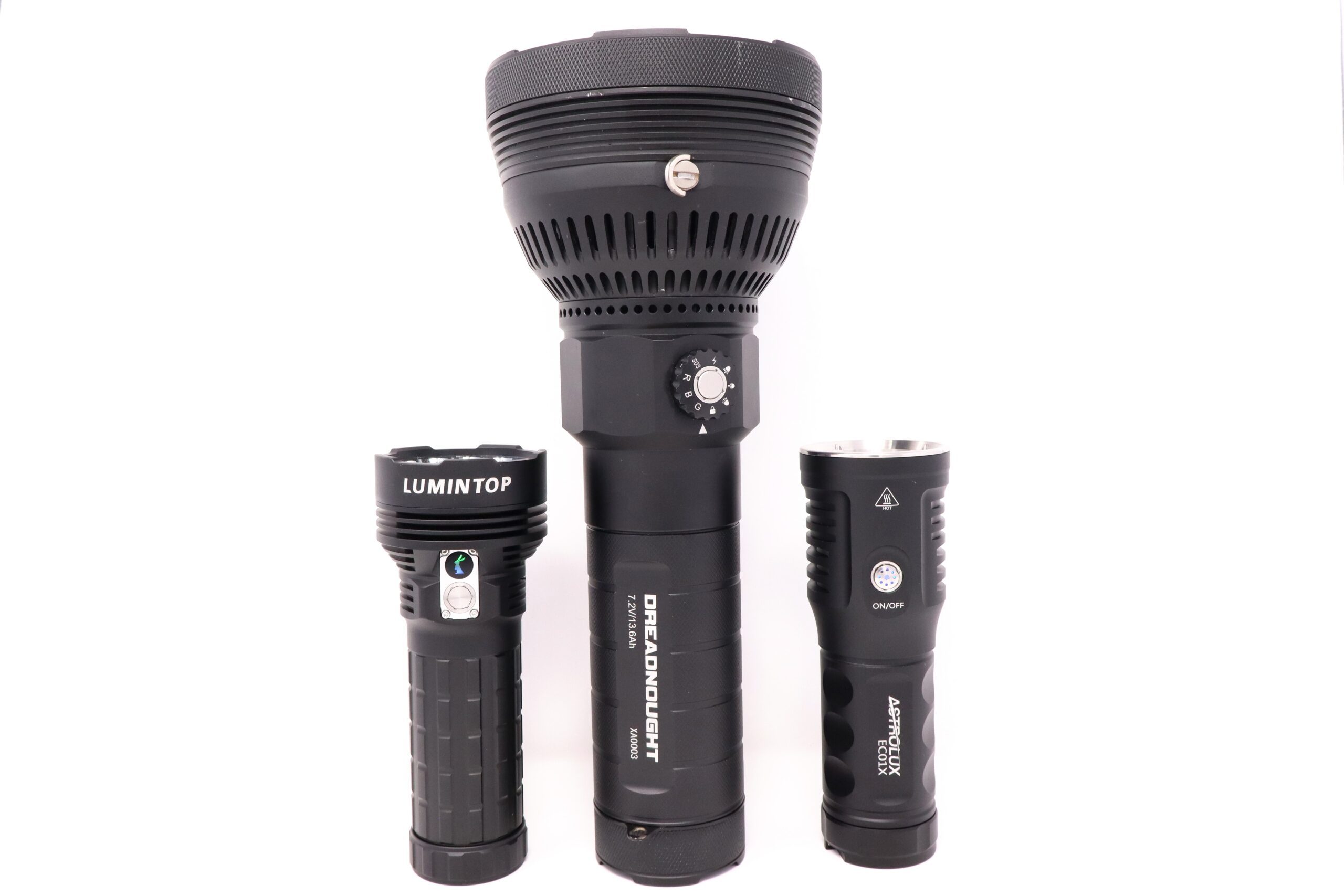
Powertac Dreadnought UI: User Interface and Driver
Some multi-output flashlights can be a bit daunting to operate, depending on how the manufacturer decides to arrange the controls. Thankfully, the Dreadnought is not one of those. The control ring makes choosing your output channel very straight-foward. Well, almost… the silkscreen icon for Flood and Combo look identical in my eyes.
In the ANSI spec table that I was provided, Powertac calls the floodlight “Lighting”, the LEP-only mode simply “LEP”, and the combined option as “Lighting+LEP”.
Available modes:
- Combo (Flood + LEP): Firefly, Low, Medium, High, Turbo
- Flood: Firefly, Low, Medium, High, Turbo
- LEP (one mode only)
- Colors: Red, Green, Blue
Available blinky modes:
- Strobe (white), SOS (white), Red Strobe, Green Strobe, Blue Strobe
From OFF:
- Single click: turn on (last used mode)
From ON:
- Press and hold (Combo or Flood): change brightness
- Press and hold (Red, Green, or Blue): switch between solid on and strobe
- Single click: turn off
Mode memory:
- Yes, each output channel seems to have it’s own mode memory
- Even strobe vs solid for the RGB channels is memorized. Last used the red with its strobe function? Next time you turn on red, it’ll be in strobe mode again.
Shortcuts:
- There doesn’t appear to be any shortcuts aside from the direct access via the control ring (eg, to Strobe and SOS)
Low voltage warning/protection:
- The tail of the Dreadnought has a 5-position battery indicator that can be activated with the push of a button next to the indicator
Strobe/blinkies
- SOS: turn the control ring to SOS
- Strobe: turn the control ring to Strobe (lightning bolt icon)
- Red / Green / Blue strobes: go to the R, G, or B option on the control ring. If not currently in the strobe mode, press and hold the e-switch
Lock-out mode:
- One of the control ring options is a lockout mode
PWM
- No PWM was detected
Additional/summary info on the UI:
- I’m not sure if I’m a huge fan of the RGB modes having strobe as a memory function, but that’s a pretty small quibble
- Hopefully the silkscreen for the Flood channel gets updated before production
- I think a couple shortcuts from Off would have been handy (long-hold for Firefly and double-click for Turbo), but not a deal breaker in this kind of purpose-built light
Powertac Dreadnought Charging and batteries
The battery is built into the battery tube of the Powertac Dreadnought. I don’t have any real details on how it is constructed, but the side of the battery tube mentions that we’re looking at 7.2 volts and 13.6 Ah. If I had to take a guess, the battery is perhaps built out of six 4500 mAh 21700 cells in a 2S3P configuration. That’d put us at about the right size and electrical specs.
The tail of the Dreadnought features a 5-position battery indicator that can be activated with the push of a button next to the indicator. In the center of the tail is a large aluminum cover that pops off, and appears that it might normally be held on by a small cord. Removing that cover reveals two ports: a barrel jack and a full-size USB-A port. Charging is done through the barrel connector, using the provided power adapter. Mysteriously, the power adapter does not have any markings to indicate its voltage or power rating.
It would appear that the USB-A is for use as a powerbank. With this being a pre-production unit and no manual available, I wasn’t going to risk plugging my phone into it to see. Curiosity got the better of me, though, and I charged ahead blindly. When I first plugged my phone in with a USB-A to USB-C cable, nothing happened. But then I held down the button on the tail that would be used for checking the battery status, and my phone dinged and recognized that something was going on with charging. It then popped up with an “issue with charging accessory” warning and that’s all I needed to see to quickly unplug my phone. So… the Dreadnought might come with powerbank functionality, but we’ll have to wait and see and we get closer to production and perhaps the publication of a manual.
I was watching the battery indicator as it charged and noticed that it stopped charging (at least from what I could tell) at the 3h 42min mark, which seems pretty quick given the large capacity of the built-in battery.
| Charge type | Fits | No fit | Charge time |
|---|---|---|---|
| Flashlight with onboard charging via a power cord with barrel connector | N/A (built-in) | N/A (built-in) | 3h 42min |
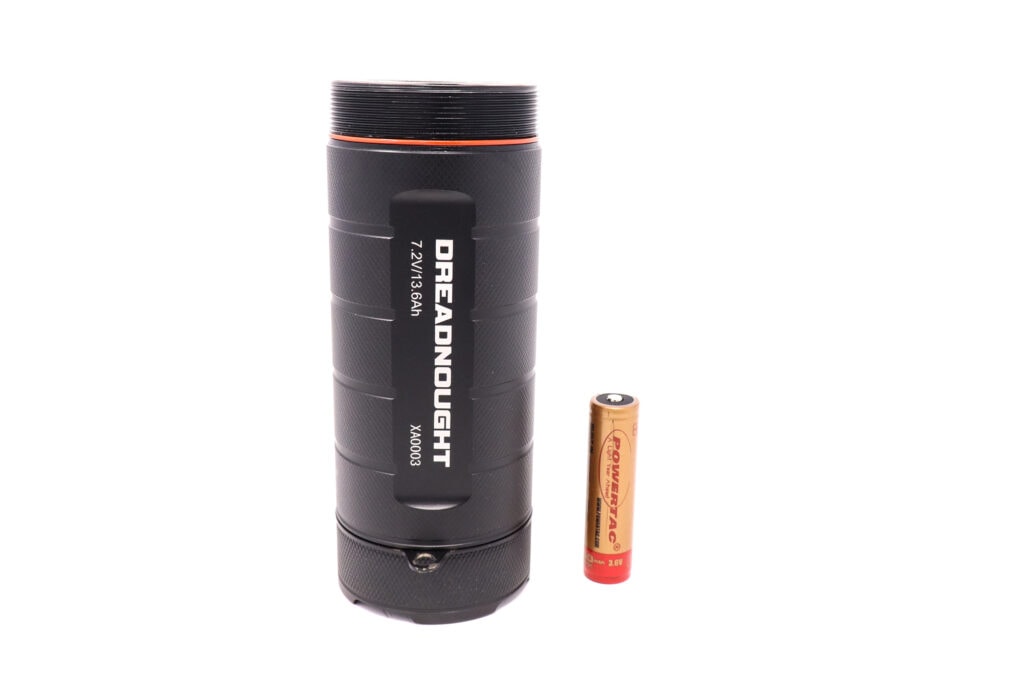
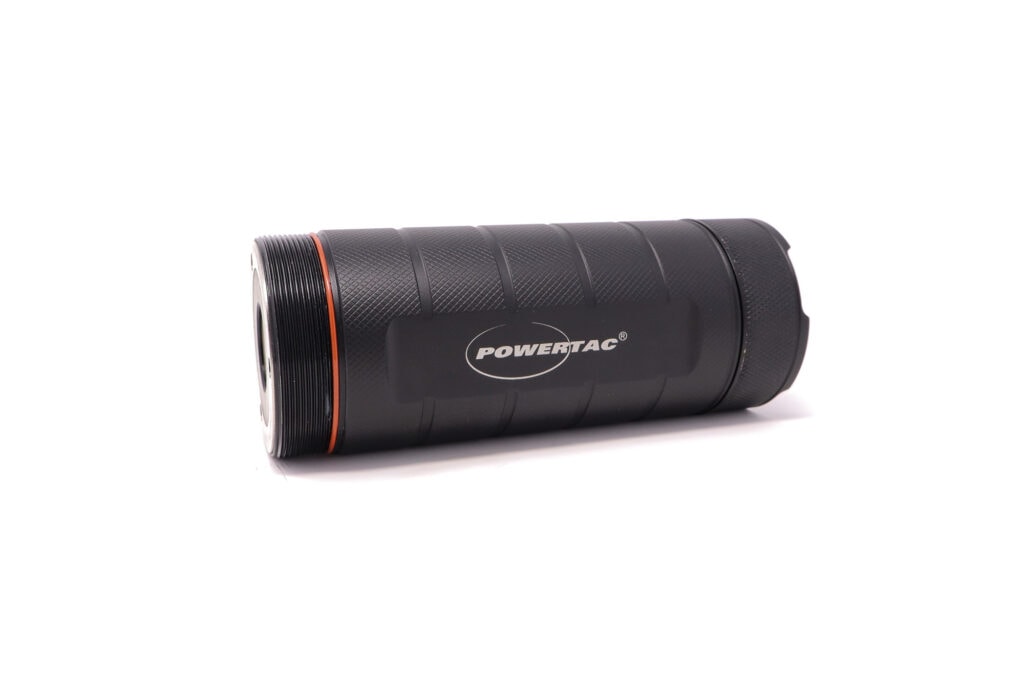

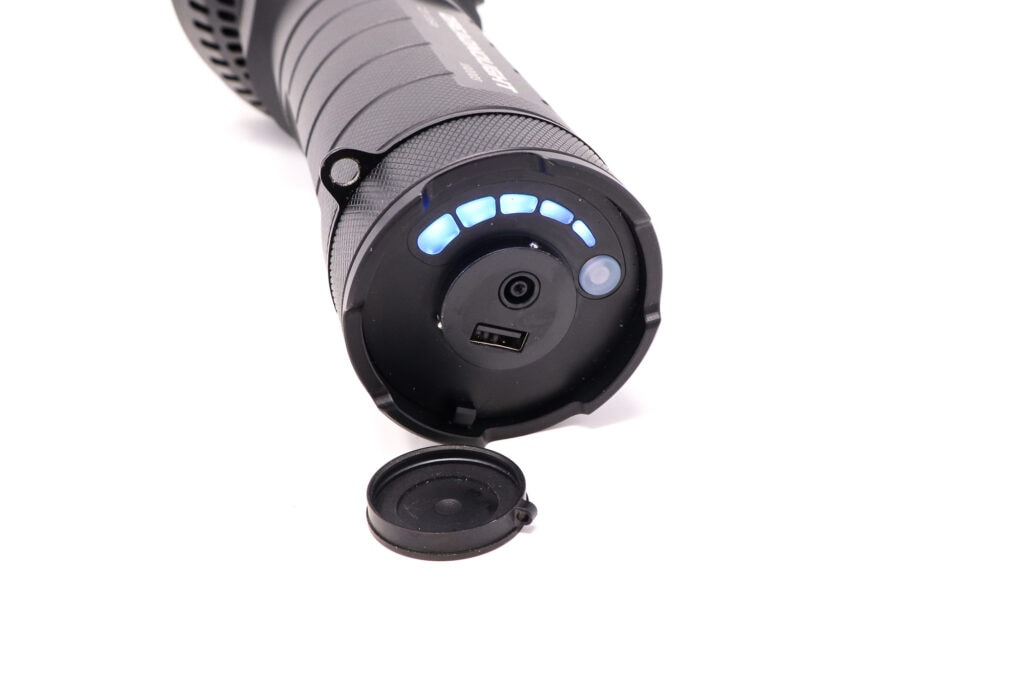
Performance test
Lumen measurements
How Lumens are Measured: Understanding ANSI FL1 Standards How Lumens are Measured: Understanding ANSI FL1 Standards: The ANSI FL1 standards specify that output in lumens should be measured 30 seconds after turning on, as this is the standardized time for measuring brightness according to the industry standard. This is why we focus on this part in our measurements. The ANSI FL1 standards require an ambient temperature of 22 ± 3°C. We record the ambient the ambient temperature to identify potential reasons for any observed discrepancies.Lux was measured by a UNI-T UT383 BT at 10 meters. Lumens were measured in a homemade lumen cube (a large, white-lined photography box) using a VEML7700 sensor, calibrated with a calibration light provided by 1Lumen. The included built-in battery was used in the tests.
Combo (Flood + LEP)
| Mode | Specified | Turn on | 30 sec. | 10 min. |
|---|---|---|---|---|
| Firefly | 5,342 lm | 6,707 lm | 6,705 lm | 6,678 lm |
| Low | 15,859 lm | 17,826 lm | 17,768 lm | 17,381 lm |
| Med | 29,969 lm | 33,374 lm | 33,168 lm | 31,996 lm |
| High | 64,039 lm | 70,633 lm | 69,215 lm | 23,637 lm |
| Turbo | 117,500 lm | 123,957 lm | 105,101 lm | 25,016 lm |
Floodlight only
| Mode | Specified | Turn on | 30 sec. | 10 min. |
|---|---|---|---|---|
| Firefly | 5,058 lm | 6,764 lm | 6,762 lm | 6,735 lm |
| Low | 15,650 lm | 17,492 lm | 17,456 lm | 17,123 lm |
| Med | 29,386 lm | 32,909 lm | 32,672 lm | 31,658 lm |
| High | 62,689 lm | 70,125 lm | 69,418 lm | 26,125 lm |
| Turbo | 120,000 lm | 133,209 lm | 116,654 lm | 27,968 lm |
Other modes
| Mode | Specified | Turn on | 30 sec. | 10 min. |
|---|---|---|---|---|
| LEP | 454 lm | 582 lm | 568 lm | 517 lm |
| Red | 259 lm | 104 lm | 102 lm | – |
| Blue | 84 lm | 509 lm | 508 lm | – |
| Green | 426 lm | 516 lm | 515 lm | – |
Ambient temperature during testing:
- 20 °C
Parasitic drain:
- N/A – couldn’t test due to battery design
I have been a bit frustrated lately with flashlights that promise massive amounts of lumens, but only to drop to <10% of their output within seconds. I understand that those setups look good on paper and might sell flashlights, but in real life, they leave a bit to be desired.
The Powertac Dreadnought is not one of those flashlights! Part of this is due to the internal fan, which does a wonderful job of keeping things cool while it continues to pump out the photons. If memory serves me right, this is my first encounter with an active-cooled flashlight, and I hope it’s not my last. Powertac seems to have implemented the fan control really well, too. For instance, it will kick on instantly when you use High or Turbo modes. But with Firefly, Low, and Medium modes, it doesn’t turn on right away.
There must be an internal temperature sensor that turns the fan on. In Medium mode, the Dreadnought ran for 3-4 minutes before the fan engaged. In Low mode, it was around 10 minutes. The fan never kicked in for Firefly, and the flashlight head was only at 36°C after 4 hours. Also, can we take a moment and have a laugh? A “firefly” mode of 5000+ lumens? Wowsers.
Trying to accurately measure the output of a 100k+ lumen flashlight with amateur/enthusiast-grade equipment takes a bit of calibration and care, and even then, there can be a reasonable margin of error. That said, I do feel pretty good about these numbers. And boy did the Powertac Dreadnought deliver! My measurements were in line with the specs that Powertac provided to me. Until the Dreadnought, I had never experienced a flashlight this powerful – and it definitely did not disappoint!
The Red, Blue, and Green measurements are a bit different than what Powertac provided. I’m not really surprised, though. I’m not really setup/tuned to make accurate measurements on those narrow wavelength outputs.
Powertac Dreadnought Battery Life: Runtime graphs
How Runtimes are Measured: Understanding ANSI FL1 Standards About ANSI FL1 runtime standards: The runtime is measured until the light drops to 10% of its initial output (30 seconds after turning on). This does not mean that the flashlight is not usable anymore. The last column shows how long the light actually works till it shuts off. If there is a + symbol, it means that the test was stopped at that particular point, but the light was actually still running. This happens on certain occasions, with certain drivers, firmware, or batteries.Combo (Flood + LEP)
| Mode | Specified | Runtime (ANSI FL1) | Time till shut off |
|---|---|---|---|
| Firefly | 21h 20min | 5h 40min | 5h 40min |
| Low | 7h 11min | 1h 42min | 1h 42min |
| Medium | 3h 48min | 1h 5min | 1h 5min |
| High | 1h 47min | 1h 4min | 1h 4min |
| Turbo | 1h 17min | 1h 1min | 1h 1min |
Floodlight only
| Mode | Specified | Runtime (ANSI FL1) | Time till shut off |
|---|---|---|---|
| Firefly | 23h 18min | 5h 47min | 5h 47min |
| Low | 7h 32min | 1h 43min | 1h 43min |
| Medium | 4h 1min | 1h 5min | 1h 5min |
| High | 1h 53min | 1h 4min | 1h 4min |
| Turbo | 1h 23min | 1h 1min | 1h 1min |
Other Modes
| Mode | Specified | Runtime (ANSI FL1) | Time till shut off |
|---|---|---|---|
| LEP | 17h 59min | 13h 10min | 13h 10min |
| Red | 25h 48min | – | – |
| Blue | 21h 18min | – | – |
| Green | 21h 18min | – | – |
If there is one thing that surprised me about the Powertac Dreadnought, it was the runtimes. The Turbo runtimes aren’t too far off from spec. But after that, they diverge pretty far. Once you get to the runtime for Firefly, it’s a 4x difference between quoted runtime and what I observed. In looking at the runtime graphs, everything looks pretty good to me (as if trying to estimate “lumen hours” for each run). So I’m quite curious how/why Powertac’s numbers are so different.
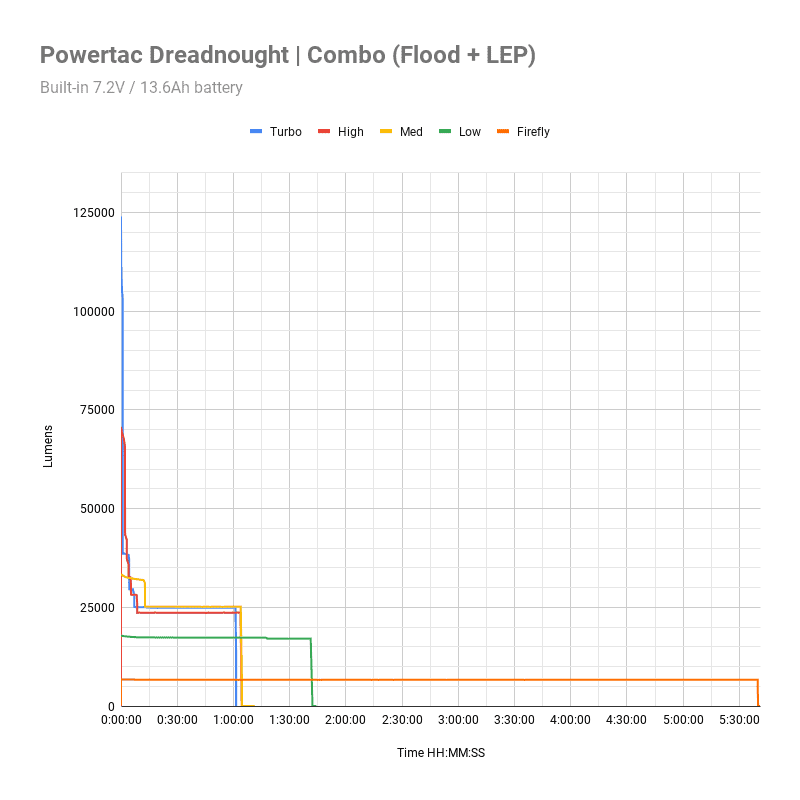
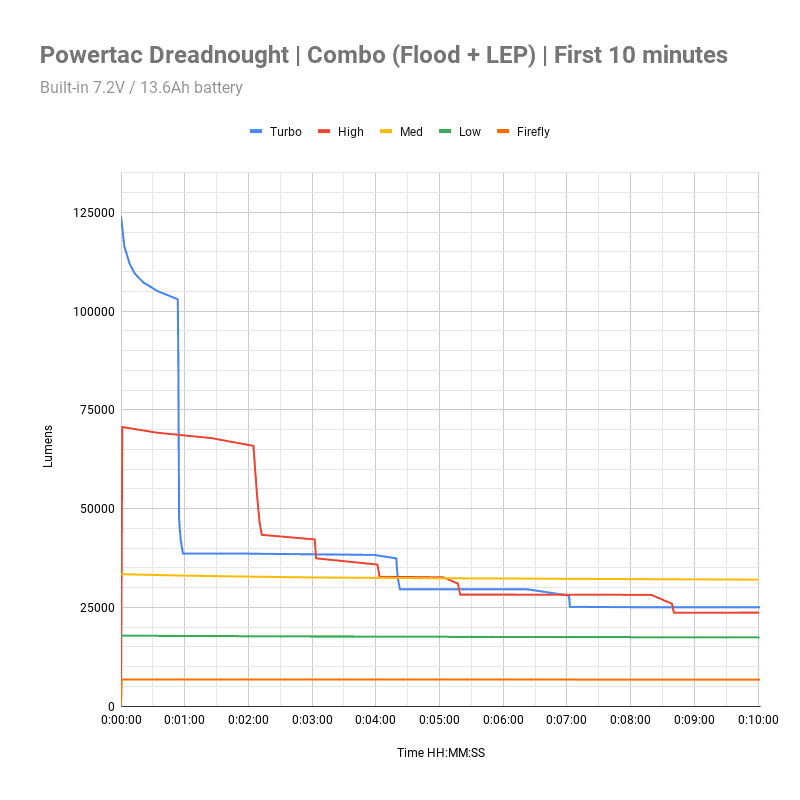
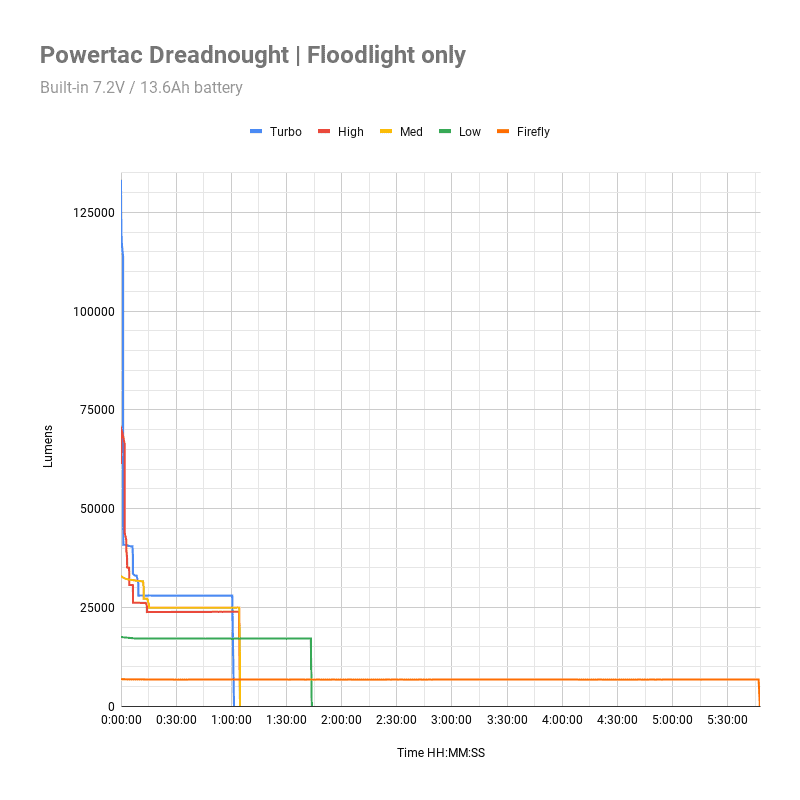
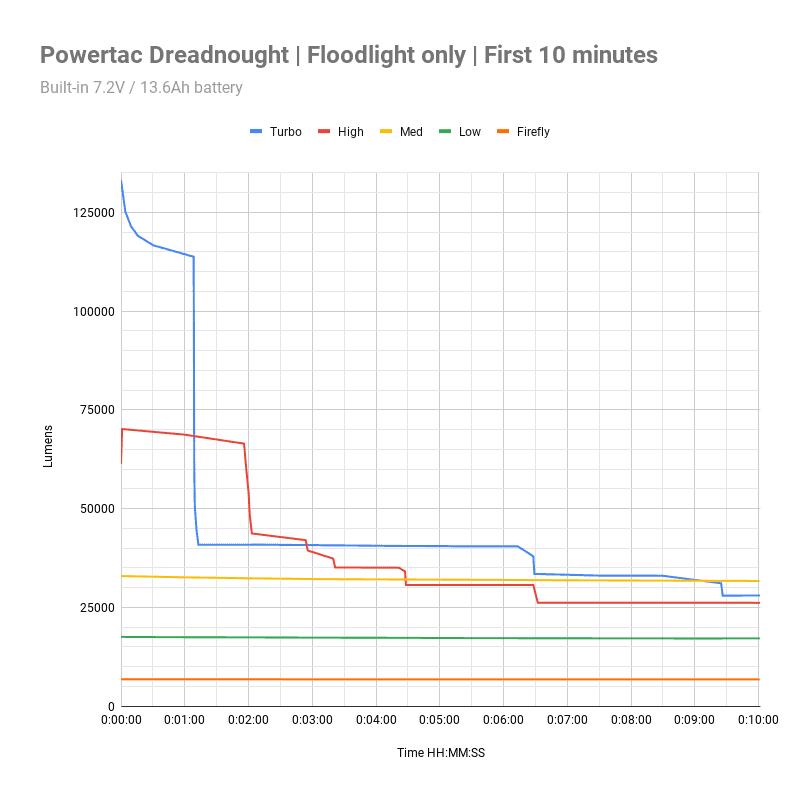
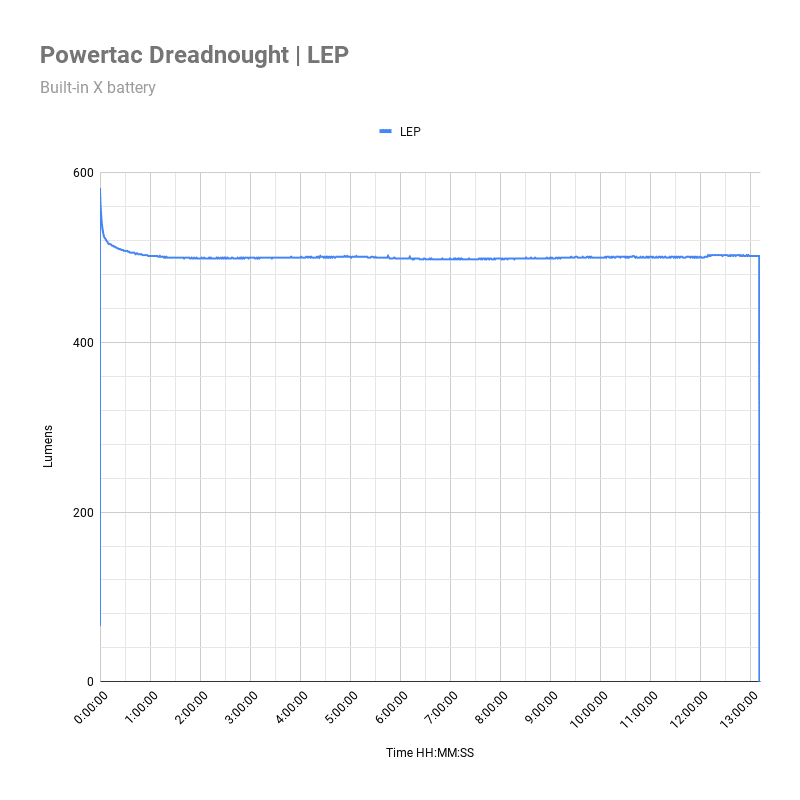
Peak beam intensity and beam distance measurements
About Peak beam intensity: Understanding ANSI FL1 Standards About peak beam intensity The calculated value of distance in meters at which the flashlight produces a light intensity of 0.25 lux. (0.25 lux is about the brightness of a full moon shining on an object). This means that the intensity has decreased so much, it becomes difficult to see darker objects, or objects that don’t reflect light. The columns ‘Meters’ and ‘Yards’ use rounded numbers.Intensity was measured at 10 meters after being turned on for 30 seconds. A UNI-T UT383 BT lux meter was used.
Combo (Flood + LEP)
| Mode | Specified | Candela measured | Meters | Yards |
|---|---|---|---|---|
| Firefly | – | 18,300 cd | 271 m | 296 yd |
| Low | – | 160,000 cd | 800 m | 875 yd |
| Medium | – | 419,800 cd | 1,296 m | 1,417 yd |
| High | – | 1,122,000 cd | 2,118 m | 2,317 yd |
| Turbo | 1,960,000 cd | 1,888,500 cd | 2,748 m | 3,006 yd |
Floodlight only
| Mode | Specified | Candela measured | Meters | Yards |
|---|---|---|---|---|
| Firefly | – | 18,000 cd | 268 m | 293 yd |
| Low | – | 54,800 cd | 468 m | 512 yd |
| Medium | – | 105,600 cd | 650 m | 711 yd |
| High | – | 217,600 cd | 933 m | 1,020 yd |
| Turbo | – | 294,400 cd | 1,085 m | 1,187 yd |
Other Modes
| Mode | Specified | Candela measured | Meters | Yards |
|---|---|---|---|---|
| LEP | – | 1,623,900 | 2,549 m | 2,787 yd |
Ambient temperature:
- 20°C
The spec listing that I have from Powertac only included a single intensity rating: an impressive 1,960,000 candela. It doesn’t say what mode/setting that was for, so I’ll attribute it to the highest mode that I tested – and they line up pretty well. My measurement works out to a throw distance of 2.7 km / 1.7 mi for the top spot, the Turbo Flood + LEP mode.
Beamshots
Camera settings and distance: Beam shots of the building are taken at 50 m (33 yd) using a Canon EOS R100 with a lens set to 18mm. Manual settings: ISO 400, 1/4sec, F4.5, 5000K.
The Blue and Green up-close beamshots used the same camera, but with manual settings: ISO 800, 1/4sec, F4.5, 5000K. The Red output was low enough that the camera didn’t want to focus, so no beamshot for that.
Beamshots of the following flashlights compared:
- Powertac Dreadnought, LEP
- Powertac Dreadnought, Combo
- Powertac Dreadnought, Flood
- Powertac Dreadnought, Green
- Powertac Dreadnought, Blue
- Lumintop DF11, Spot
- Lumintop DF11, Combo
- Lumintop DF11, Flood
Please note that the following beamshots are mainly intended to showcase the beam pattern and beam quality, rather than overall performance. These images are typically taken directly after activation, and in different seasons or weather conditions, and therefore do not fully represent its overall performance. For accurate performance metrics, such as output, beam distance, and runtimes, you need to look at the performance section of this review.
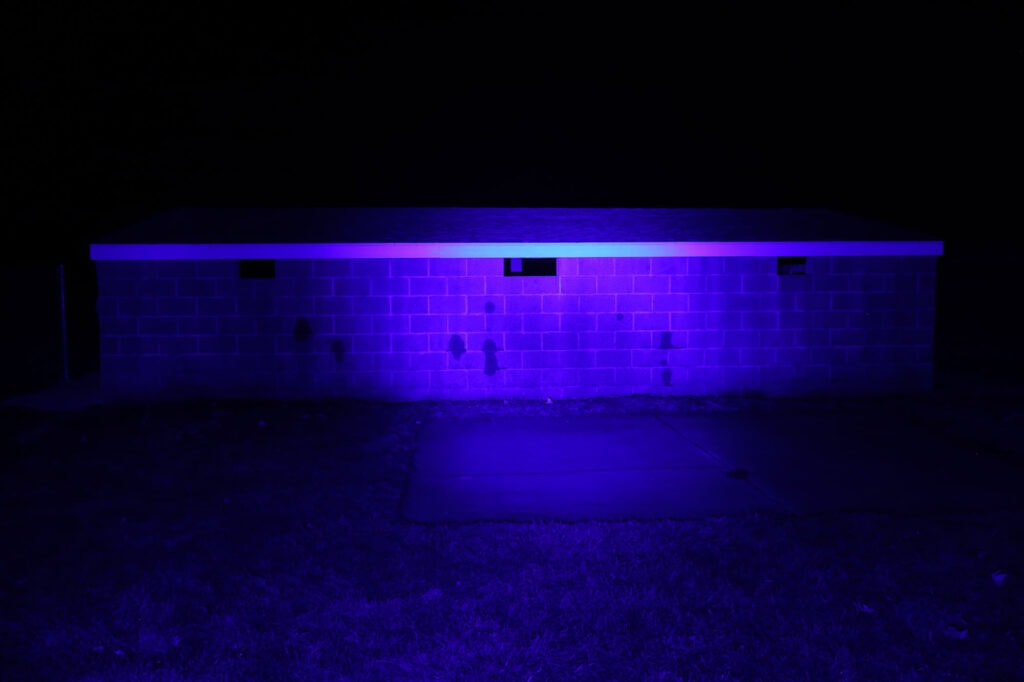
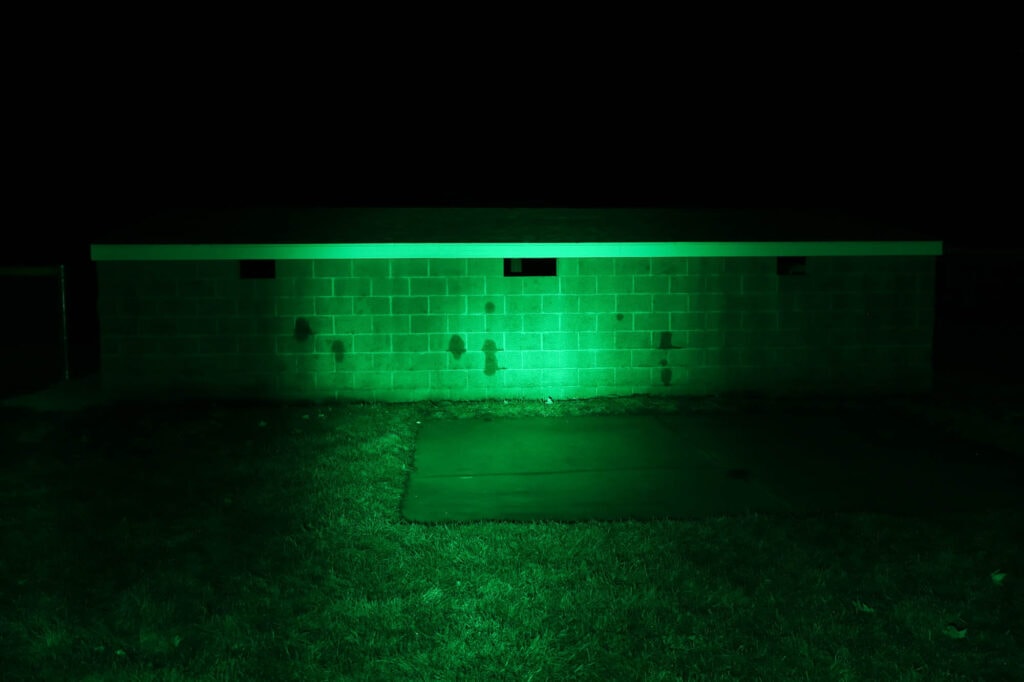
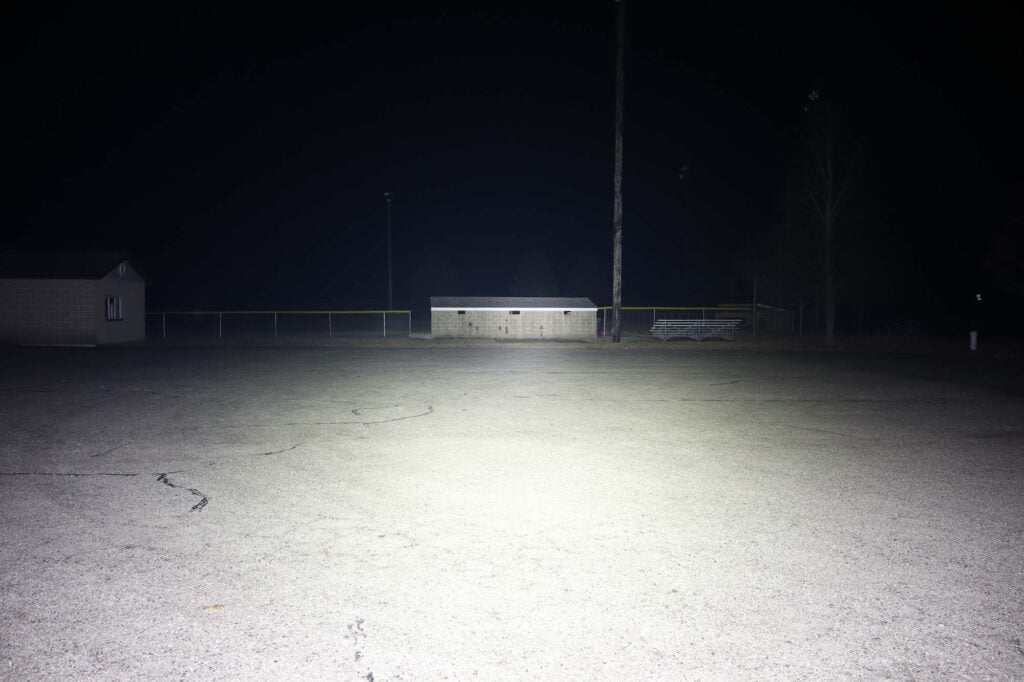
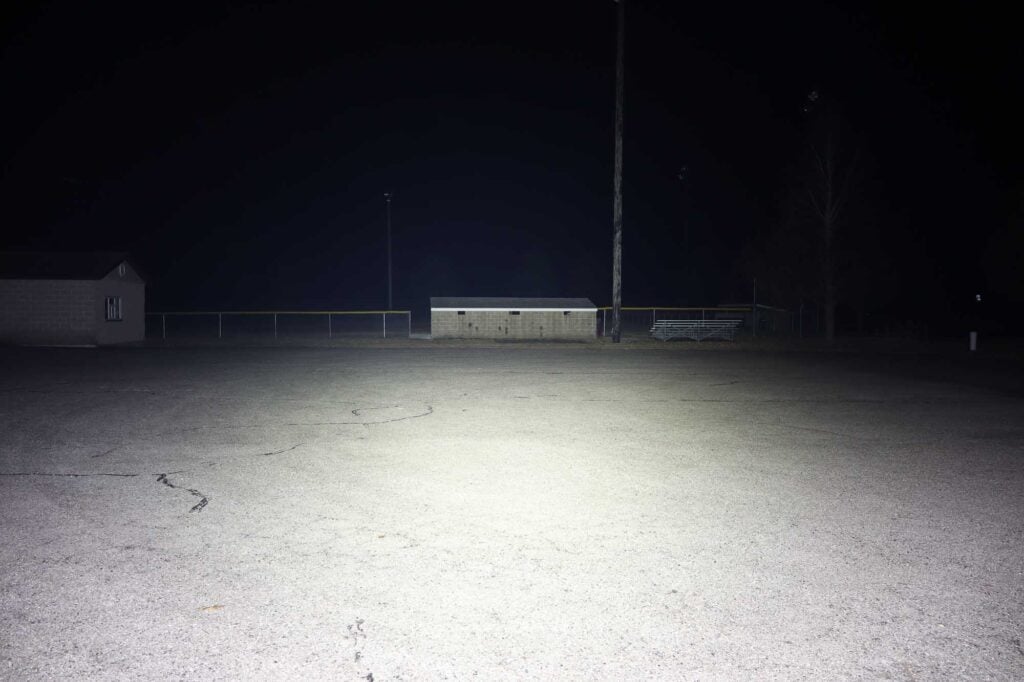
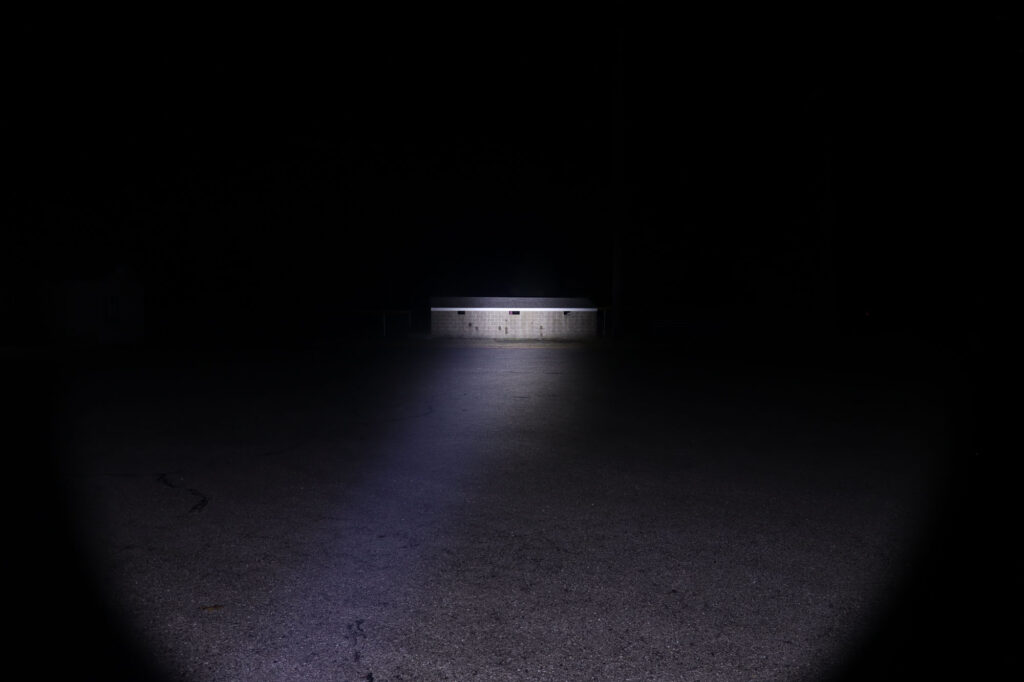
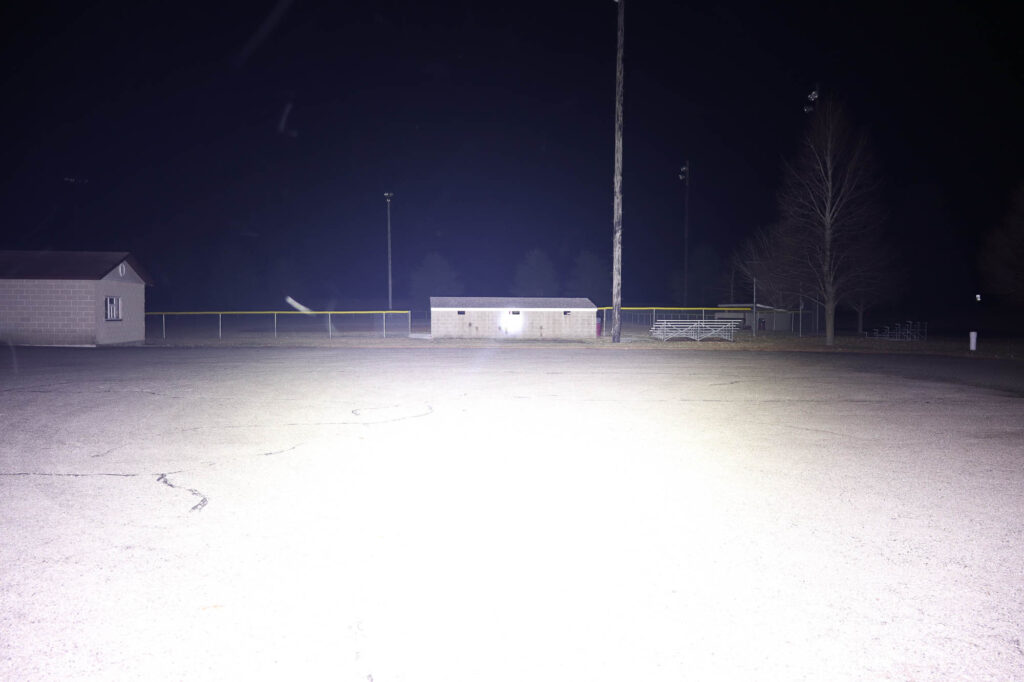
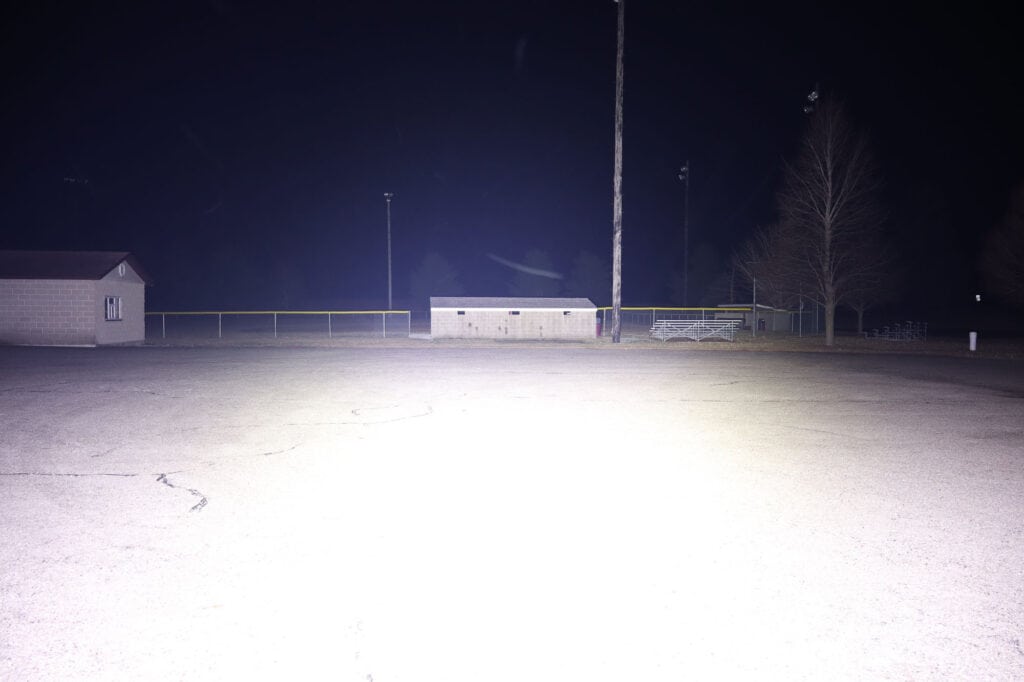
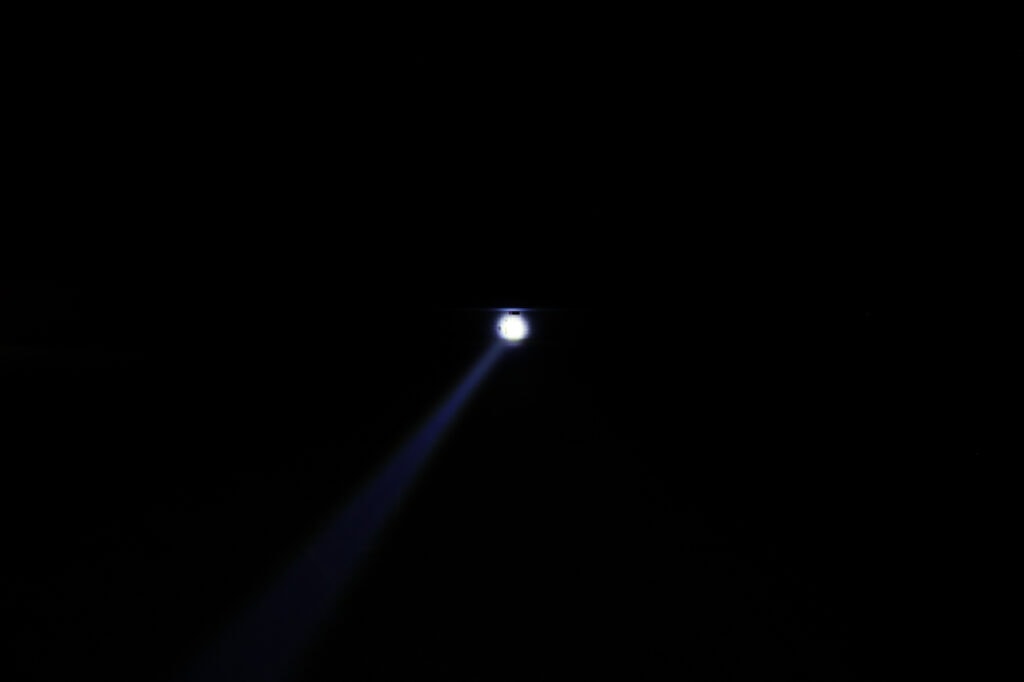
Disclaimer: This flashlight was sent to us for review at no cost by Powertac. We have not been paid to review, nor have we been holding back on problems or defects.
Final Verdict
Pros
- Massive output
- Actively cooled
- Far-reaching LEP
- Simple UI
- Decent recharge time
Cons
- Misses runtime lengths
- Icons for flood and combo are too similar
- No pocket clip (kidding!)
Explanation on star ratings:
1: Avoid: a match would be a better choice – 2: Poor: significant defect or issues; almost unusable – 3: Average: some defects or issues; but still usable 4: Good: recommended (minor issues) – 5: Great: highly recommended

5 stars: ★★★★★
While our star rating provides a reliable indicator, we encourage you to read the full review to make an informed decision based on your own needs and preferences.
The Powertac Dreadnought really lives up to its name. Mass-wise, this thing is 3.7 kg (over 8 lbs) and easily pumps out lumens in the 6-figure range. And it’s not just a flood monster – the LEP module in the middle projects a very intense, far-reaching beam.
The internal fan keeps things running cool, without any worries of steep, quick dropoffs like most other high-output lights. The rotary control switch for mode selection paired with the center e-switch for on/off/modes keeps the Dreadnought easy to operate.
If you’re in the target-market for the Dreadnought (search & rescue) or just have a deep bankroll and a fascination with things that light up, this new offering from Powertac is sure to impress.
Buy your Powertac Dreadnought here
The dreadnought is not ready for sale yet. For the time being, have a look at its smaller sibling, the X10K.
1lumen selects and reviews products personally. We may earn affiliate commissions through our links, which help support our testing.